User Manual

SR630n
User Manual
VER: 1.0

User Manual
i
Contents
1 Safety Precautions ............................................................................................. 1
2 Overview ............................................................................................................ 2
2.1 Application ............................................................................................. 2
2.2 Features ................................................................................................ 3
2.3 Standards Compatibility and Compliance .............................................. 4
3 Hardware Description and Installation ............................................................... 5
3.1 Hardware Description ............................................................................ 5
3.1.1 Front Panel ................................................................................. 5
3.1.2 Rear Panel and Side Panel ........................................................ 6
3.2 Hardware Installation ............................................................................. 7
3.2.1 Choosing the Best Location for Wireless Operation ................... 8
3.2.2 Connecting the Device ............................................................... 8
4 PC Network Configuration and Login ............................................................... 10
4.1 PC Network Configuration ................................................................... 10
4.2 Logging In to the DSL Router .............................................................. 12
5 Web-Based Management ................................................................................ 13
5.1 Device Information ............................................................................... 13
5.1.1 Summary .................................................................................. 14
5.1.2 WAN ......................................................................................... 15
5.1.3 Statistics .................................................................................... 16
5.1.4 LAN ........................................................................................... 16
5.1.5 WAN Service ............................................................................ 16
5.1.6 xTM ........................................................................................... 17
5.1.7 xDSL ......................................................................................... 17
5.1.8 Route ........................................................................................ 20
5.1.9 ARP .......................................................................................... 21
5.1.10 DHCP .................................................................................. 21
5.2 Advanced Setup .................................................................................. 21
5.2.1 Layer2 Interface ........................................................................ 22
5.2.2 WAN Service ............................................................................ 26
5.2.3 3G WAN Service ....................................................................... 51
5.2.4 LAN Configuration .................................................................... 55

User Manual
ii
5.2.5 NAT ........................................................................................... 61
5.2.6 Security ..................................................................................... 65
5.2.7 Parental Control ........................................................................ 68
5.2.8 Quality of Service...................................................................... 70
5.2.9 Routing ..................................................................................... 74
5.2.10 DNS ..................................................................................... 78
5.2.11 DSL ..................................................................................... 79
5.2.12 UPnP ................................................................................... 80
5.2.13 DNS Proxy ........................................................................... 81
5.2.14 Print Server ......................................................................... 81
5.2.15 DLNA ................................................................................... 82
5.2.16 Packet Acceleration ............................................................. 83
5.2.17 Storage Service ................................................................... 83
5.2.18 Interface Grouping............................................................... 84
5.2.19 IP Tunnel ............................................................................. 85
5.2.20 IPSec ................................................................................... 87
5.2.21 Certificate ............................................................................ 90
5.2.22 Power Management ............................................................ 94
5.2.23 Multicast .............................................................................. 95
5.3 Wireless ............................................................................................... 96
5.3.1 Basic Settings ........................................................................... 97
5.3.2 Security ..................................................................................... 98
5.3.3 MAC Filter ............................................................................... 106
5.3.4 Wireless Bridge....................................................................... 107
5.3.5 Advanced Settings .................................................................. 108
5.3.6 Station Info ...............................................................................111
5.4 Voice ...................................................................................................111
5.4.1 VoIP Status ..............................................................................111
5.4.2 SIP Basic Setting .................................................................... 112
5.4.3 SIP Advanced Setting ............................................................. 116
5.4.4 SIP Extra Setting .................................................................... 121
5.4.5 SIP Debug Setting .................................................................. 121
5.4.6 VoIP Functionality ................................................................... 122
5.5 Diagnostics ........................................................................................ 126

User Manual
iii
5.5.1 Diagnostics ............................................................................. 126
5.5.2 Fault Management .................................................................. 127
5.6 Management ...................................................................................... 128
5.6.1 Settings ................................................................................... 129
5.6.2 System Log ............................................................................. 130
5.6.3 SNMP Agent ........................................................................... 131
5.6.4 TR-69 Client ............................................................................ 132
5.6.5 Internet Time ........................................................................... 132
5.6.6 Access Control........................................................................ 134
5.6.7 Update Software ..................................................................... 135
5.6.8 Reboot .................................................................................... 136
6 Q&A ................................................................................................................ 136

User Manual
1
1 Safety Precautions
Read the following information carefully before operating the device. Please follow
the following precaution items to protect the device from risks and damage caused
by fire and electric power:
Use volume labels to mark the type of power.
Use the power adapter that is packed within the device package.
Pay attention to the power load of the outlet or prolonged lines. An
overburden power outlet or damaged lines and plugs may cause electric
shock or fire accident. Check the power cords regularly. If you find any
damage, replace it at once.
Proper space left for heat dissipation is necessary to avoid any damage
caused by overheating to the device. The holes on the device are designed
for heat dissipation to ensure that the device works normally. Do not cover
these heat dissipation holes.
Do not put this device close to a place where a heat source exits or high
temperature occurs. Avoid the device from direct sunshine.
Do not put this device close to a place where is over damp or watery. Do not
spill any fluid on this device.
Do not connect this device to any PC or electronic product, unless our
customer engineer or your broadband provider instructs you to do this,
because any wrong connection may cause any power or fire risk.
Do not place this device on an unstable surface or support.

User Manual
2
2 Overview
The xDSL Router integrates wireless LAN, USB, and VoIP service into one unit. It
is designed to provide a simple and cost-effective xDSL Internet connection for a
private Ethernet and 802.11b/802.11g/802.11n wireless network. The Router
combines high-speed xDSL Internet connection, Ethernet uplink, IP routing for the
LAN and wireless connectivity in one package. It is usually preferred to provide
high access performance applications for the individual users, the SOHOs, and the
small enterprises. The Router supports 3G WAN service.
The Router is easy to install and use. The Router connects to an Ethernet LAN or
computers via standard Ethernet ports. The xDSL connection is made using
ordinary telephone line with standard connectors. You can connect the Ethernet
interface of WAN to Internet with Ethernet cable for ETH uplink. Multiple
workstations can be networked and connected to the Internet by a single Wide
Area Network (WAN) interface and single global IP address. The advanced
security enhancements, packet filtering and port redirection, can help protect your
network from potentially devastating intrusions by malicious agents from outside
your network.
Network and Router management is done through the web-based management
interface that can be accessed through the local Ethernet using any web browser.
You may also enable remote management to enable configuration of the Router via
the WAN interface.
2.1 Application
Home gateway
SOHOs
Small enterprises
Higher data rate broadband sharing
Audio and video streaming and transfer
PC file and application sharing
Network and online gaming
Voice over IP (VoIP)
USB storage

User Manual
3
3G WAN service
2.2 Features
User-friendly GUI for web configuration
Several pre-configured popular games. Just enable the game and the port
settings are automatically configured.
Compatible with all standard Internet applications
Industry standard and interoperable DSL interface
Simple web-based status page displays a snapshot of system configuration,
and links to the configuration pages
Downloadable flash software updates
Support for up to 8 permanent virtual circuits (PVC)
Support for up to 8 PPPoE sessions
Support RIP v1 & RIP v2
WLAN with high-speed data transfer rates, compatible with IEEE 802.11b/g/n
Optimized Linux 2.6 Operating System
IP routing and bridging
Asynchronous transfer mode (ATM) and digital subscriber line (DSL) support
Packet Transfer Mode (PTM)
Ethernet (ETH) Transfer Mode
Point-to-point protocol (PPP)
Network/port address translation (NAT/PAT)
Quality of service (QoS)
Wireless LAN security: WPA, 802.1x, RADIUS client
Universal plug-and-play(UPnP)
File server for network attached storage (NAS) devices
Print server
Web filtering
Management and control
- Web-based management (WBM)
- Command line interface (CLI)
- TR-069 WAN management protocol
- Simple Network Management Protocol (SNMP)
Remote update
System statistics and monitoring

User Manual
4
DSL router is targeted at the following platforms: DSL modems, wireless
access points and bridge.
2.3 Standards Compatibility and Compliance
Support application level gateway (ALG)
ITU G.992.1 (G.dmt)
ITU G.992.2 (G.lite)
ITU G.994.1 (G.hs)
ITU G.992.3 (ADSL2)
ITU G.992.5 (ADSL2+)
ITU G.993.1 (VDSL)
ITU G993.2 (VDSL2)
3G (WCDMA, CDMA2000, TD-SCDMA)
ANSI T1.413 Issue 2
IEEE 802.3
IEEE 802.3u
IEEE 802.11b
IEEE 802.11g
IEEE 802.11n
RFC3261 (SIP for VoIP)
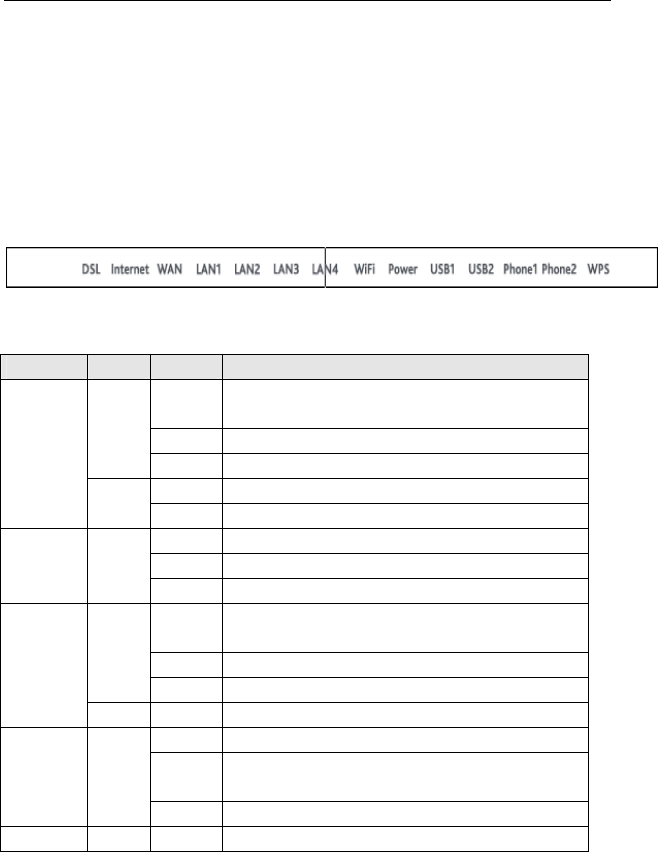
User Manual
5
3 Hardware Description and Installation
Note:
The figures in this document are for reference only.
3.1 Hardware Description
3.1.1 Front Panel
Figure 1 Front panel
The following table describes the indicators on the front panel.
Indicator Color Status Description
Power
Green
On The device is powered on and the device operates
normally.
Blink The software is upgrading.
Off The device is powered off.
Red On The device is initiating.
Blink The software is upgrading.
DSL Green
On DSL link has established.
Blink The DSL line is training.
Off Device is powered off.
Internet Green
On Internet is synchronized successfully in the route
mode.
Blink Internet data is being transmitted.
Off Ethernet interface is disconnected.
Red On Authentication has failed.
LAN
1/2/3/4 Green
On The Ethernet interface is connected.
Blink Data is being transmitted through the Ethernet
interface.
Off The Ethernet interface is disconnected.
USB1/2 Green On The connection of 3G or USB flash disk has

User Manual
6
Indicator Color Status Description
established.
Blink Data is being transmitted.
Off No signal is detected.
WLAN Green
On WLAN is enabled.
Blink Data is being transmitted through the wireless
interface.
Off WLAN is disabled.
WPS Green
On Connection succeeds under Wi-Fi Protected
Setup.
Blink Negotiation is in progress under Wi-Fi Protected
Setup.
Off Wi-Fi Protected Setup is disabled.
TEL1/2 Green
Off No FXS signal is detected.
Blink The user data is passing through FXS port.
On The FXS interface is ready to work.
3.1.2 Rear Panel and Side Panel
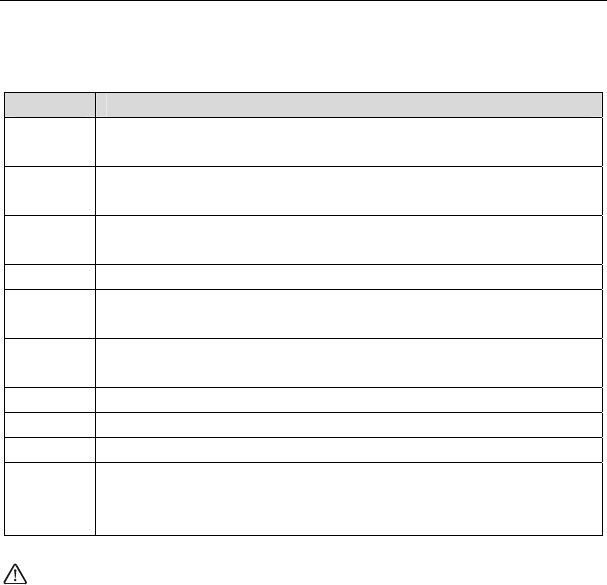
User Manual
7
Figure 2 Rear panel Figure 3 Side
panel
The following table describes the interfaces and the buttons.
Interface Description
DSL RJ-11 port. Connect the router to DSL connector or splitter through
telephone cable.
TEL1/2 RJ-11 FXS port, using the telephone cable to connect the telephone
set.
LAN 4~1 RJ-45 port, for connecting the router to a PC or another network
device.
WAN For connecting Ethernet cable to provide Ethernet uplink.
Reset Press the button for at least 1 second and then release it. System
restores the factory default settings.
USB1/2 USB port, for connecting the 3G network card or other USB storage
devices.
Power Power interface, for connecting the power adapter.
On/Off Power switch.
WLAN WLAN switch, for enabling or disabling the WLAN function.
WPS
This button is used for enabling WPS PBC mode. If WPS is enabled,
press this button, and then the wireless router starts to accept the
negotiation of PBC mode.
Warning:
Do not press the Reset button unless you want to clear the current settings. The
Reset button is in a small circular hole on the rear panel. If you want to restore the
default settings, please press the Reset button gently for 1 second with a fine needle
inserted into the hole and then release the button. The system reboots and returns to
the factory defaults.
3.2 Hardware Installation

User Manual
8
3.2.1 Choosing the Best Location for Wireless
Operation
Many environmental factors may affect the effective wireless function of the DSL
Router. If this is the first time that you set up a wireless network device, read the
following information:
The access point can be placed on a shelf or desktop, ideally you should be able to
see the LED indicators in the front, as you may need to view them for troubleshooting.
Designed to go up to 100 meters indoors and up to 300 meters outdoors, wireless
LAN lets you access your network from anywhere you want. However, the numbers of
walls, ceilings, or other objects that the wireless signals must pass through limit signal
range. Typical ranges vary depending on types of materials and background RF
noise in your home or business.
3.2.2 Connecting the Device
Step 1 Connect the DSL port of the router and the Modem port of the splitter
with a telephone cable; connect the phone to the phone port of the
splitter through a cable; and connect the incoming line to the Line port of
the splitter.
The spliiter has three ports:
Line: Connect to a wall phone jack (RJ-11 jack)
Modem: Connect to the Line interface of the router
Phone: Connect to a telephone set
Step 2 Connect the LAN port of the router to the network card of the PC through
an Ethernet cable.
Step 3 Plug the power adapter to the wall outlet and then connect the other end
of it to the Power port of the router.
The followig figure displays the connection of the DSL router, PC, and telephones.
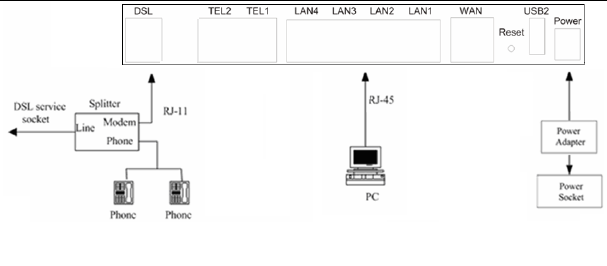
User Manual
9
Figure 4 Connecting the DSL router
Note:
If you use 3G WAN service, connect the 3G USB data card to the USB port of
the router.
If you use the Ethernet uplink, connect the WAN interface that is defined to the
Internet with Ethernet cable.
The xDSL uplink, 3G WAN service, and Ethernet uplink can not coexist.

User Manual
10
4 PC Network Configuration and Login
4.1 PC Network Configuration
Each network interface on the PC should either be configured with a statically defined
IP address and DNS address, or be instructed to automatically obtain an IP address
using the network DHCP server. DSL router provides a DHCP server on its LAN and
it is recommended to configure your LAN to automatically obtain its IP address and
DNS server IP address.
The configuration principle is identical but should be carried out differently on each
operating system.
The following displays the TCP/IP Properties dialog box on Windows XP.

User Manual
11
Figure 5 IP and DNS configuration
TCP/IP configuration steps for Windows XP are as follows:
Step 1 Choose Start > Control Panel > Network Connections.
Step 2 Right-click the Ethernet connection icon and choose Properties.
Step 3 On the General tab, select the Internet Protocol (TCP/IP) component
and click Properties.
Step 4 The Internet Protocol (TCP/IP) Properties window appears.

User Manual
12
Step 5 Select the Obtain an IP address automatically radio button.
Step 6 Select the Obtain DNS server address automatically radio button.
Step 7 If you want to set the IP address and subnet mask manually, you can set
the IP address and subnet mask of the computer to 192.168.1.x and
255.255.255.0 respectively. The range for x is from 2 to 254.
Step 8 Click OK to save the settings.
4.2 Logging In to the DSL Router
To log in to the DSL router, do as follows:
Step 1 Open a Web browser on your computer.
Step 2 Enter http://192.168.1.1 (the default IP address of the DSL router) in the
address bar. The login page appears.
Step 3 Enter the user name and the password. The default username and
password of the super user are admin and admin. The username and
password of the common user are user and user. You need not enter
the username and the password again if you select the option
Remember my password. It is recommended to change these default
values after logging in to the DSL router for the first time.
Step 4 Click OK to log in to the Web page. Otherwise, please click Cancel to
exit the login page.
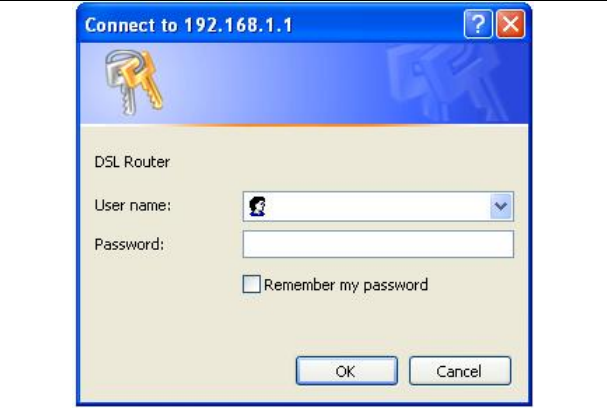
User Manual
13
Figure 6 Login page
After logging in to the DSL router as a super user, you can query, configure, and
modify all the settings, and diagnose the system
5 Web-Based Management
This chapter describes how to use Web-based management of the DSL router, which
allows you to configure and control all of DSL router features and system parameters
in a user-friendly GUI.
5.1 Device Information
Choose Device Info, and the submenus of Device Info are shown as below:

User Manual
14
5.1.1 Summary
Choose Device Info > Summary, and the following page appears.

User Manual
15
This page displays the device information such as the board ID, software version, and
the information of your WAN connection such as the upstream rate and the LAN
address.
5.1.2 WAN
Choose Device Info > WAN and the following page appears.
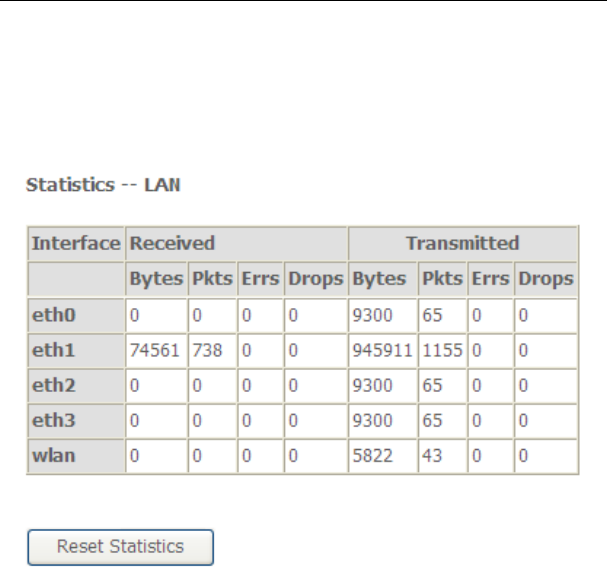
User Manual
16
This page displays the information of the WAN interface, such as the connection
status, and the IP address.
5.1.3 Statistics
5.1.4 LAN
Choose Device Info > Statistics > LAN and the following page appears.
In this page, you can view the statistical information about the recevied and
transmitted data packets of the Ethernet and wireless interfaces.
Click Reset Statistics to restore the values to zero and recount them.
5.1.5 WAN Service
Choose Device Info > Statistics > WAN Service and the following page appears.

User Manual
17
In this page, you can view the statistical information about the recevied and
transmitted data packets of the WAN interface.
Click Reset Statistics to restore the values to zero and recount them.
5.1.6 xTM
Choose Device Info > Statistics > xTM and the following page appears.
In this page, you can view the statistical information about the recevied and
transmitted data packets at the xTM interfaces.
Click the Reset button to restore the values to zero and recount them.
5.1.7 xDSL
Choose Device Info > Statistics > xDSL and the following page appears.

User Manual
18
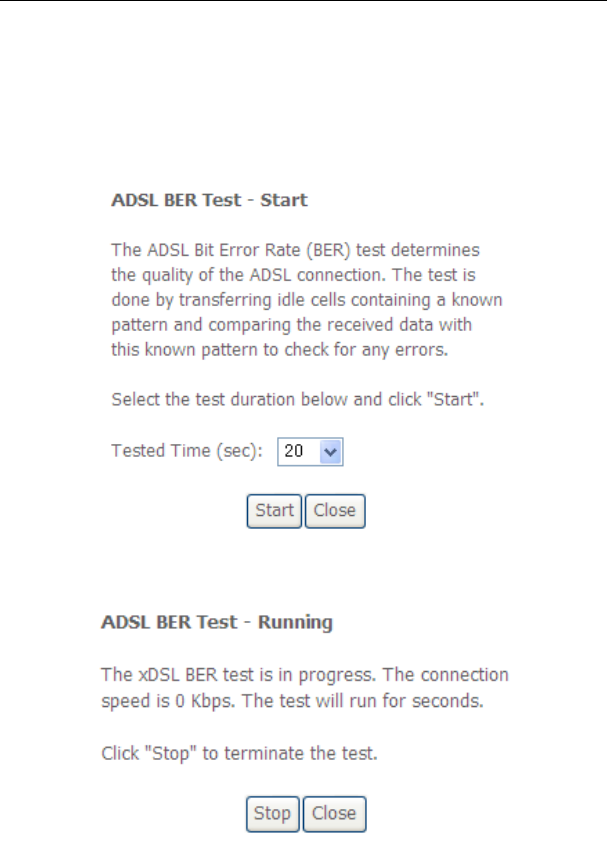
User Manual
19
In this page, you can view the statistical information about the recevied and
transmitted data packets of the xDSL interfaces.
Click xDSL BER Test to test the xDSL Bit Error Rate.
Click Reset Statistics to restore the values to zero and recount them.
xDSL BER Test
Click xDSL BER Test to perform a bit error rate (BER) test on the DSL line. The test
page is as follows:
The Tested Time (sec) can be 1, 5, 10, 20, 60, 120, 180, 240, 300, or 360. Select a
time in the drop-down list and click Start. The following pages appear.
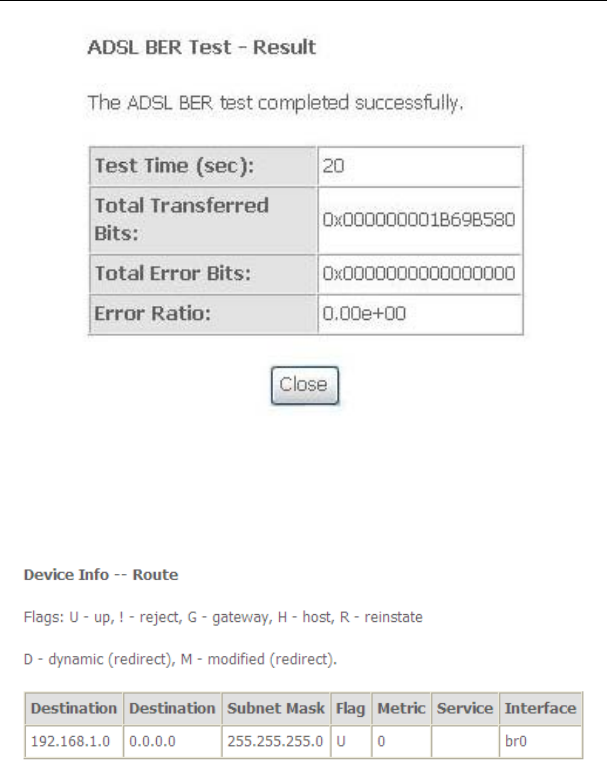
User Manual
20
When the ADSL BER test completes, the following page appears.
Note:
If the BER reaches e-5, you cannot access the Internet.
5.1.8 Route
Choose Device Info > Route and the following page appears.
In this page, you can view the route table information.
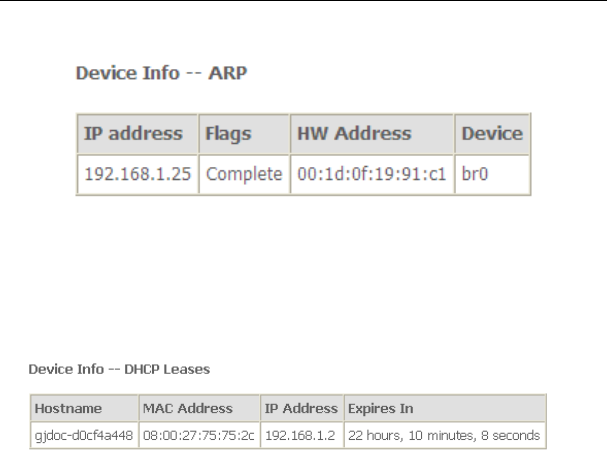
User Manual
21
5.1.9 ARP
Choose Device Info > ARP and the following page appears.
In this page, you can view the MAC address and IP address information of the device
connected to the router.
5.1.10 DHCP
Choose Device Info > DHCP and the following page appears.
In this page, you can view the host name, the IP address assigned by the DHCP
server, the MAC address this is corresponding to the IP address, and the DHCP lease
time.
5.2 Advanced Setup
Choose Advanced Setup and the submenus of Advanced Setup are shown as
below:
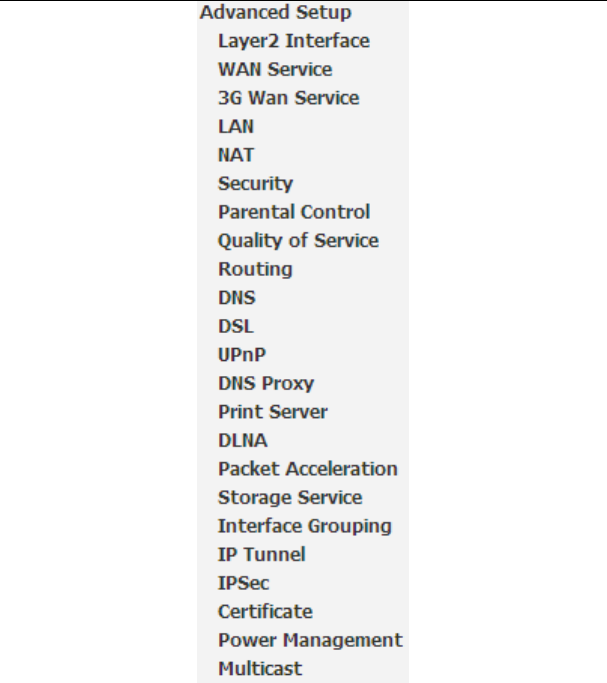
User Manual
22
5.2.1 Layer2 Interface
5.2.1.1 ATM Interface
Choose Advanced Setup > Layer2 Interface > ATM Interface . In this page, you
can add or remove to configure DSL ATM Interfaces.
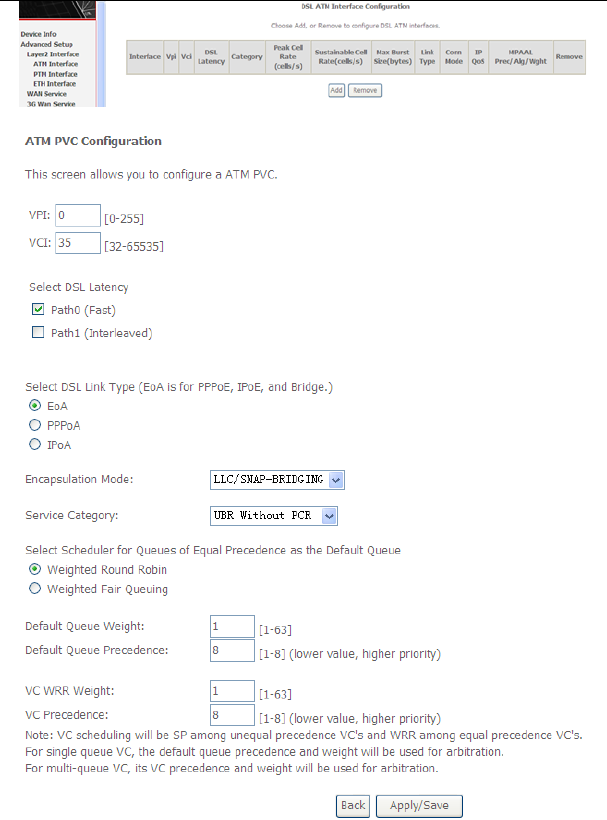
User Manual
23
Click Add to add ATM Interface and the following page appears.
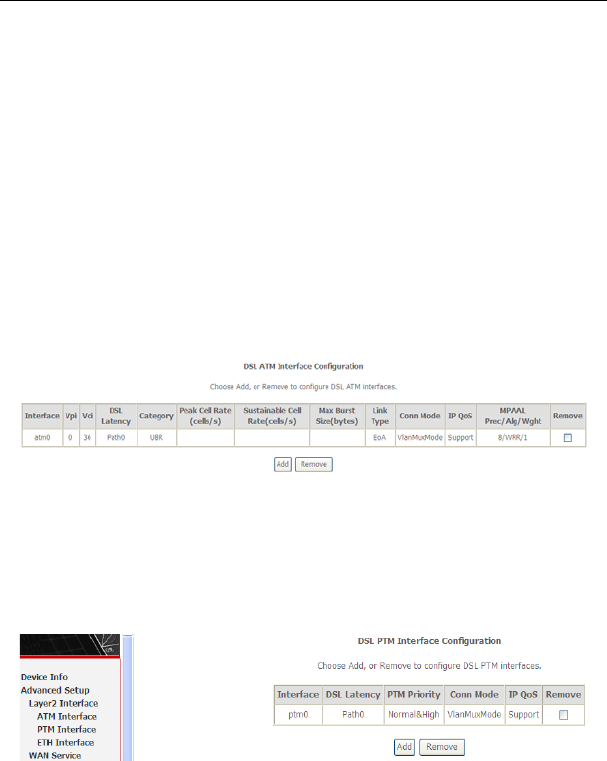
User Manual
24
In this page, you can enter this PVC (VPI and VCI) value, and select DSL link type
(EoA is for PPPoE, IPoE, and Bridge.), encapsulation mode, service category.
VPI (Virtual Path Identifier): The virtual path between two points in an ATM
network, and its valid value is from 0 to 255.
VCI (Virtual Channel Identifier): The virtual channel between two points in
an ATM network, ranging from 32 to 65535 (1 to 31 are reserved for known
protocols).
DSL Link Type: EoA (it is for PPPoE, IPoE, and Bridge), PPPoA, or IPoA
Encapsulation Mode: LLC/SNAP-BRIDGING, or VC/MUX
Service Category: UBR Without PCR, UBR With PCR, CBR, Non Realtime
VBR, Realtime VBR.
Select Scheduler for Queues of Equal Precedence as the Default
Queue: Weighted Round Robin or Weighted Fair Queuing.
Click Apply/Save to save the configuration, and return the following page:
If you want to remove this Interface, please select the Remove check box and click
Remove.
5.2.1.2 PTM Interface
Choose Advanced Setup > Layer2 Interface > PTM Interface, and the following
page appears. In this page, you can add or remove to configure PTM WAN
Interfaces.
Click Add and the following page appears.
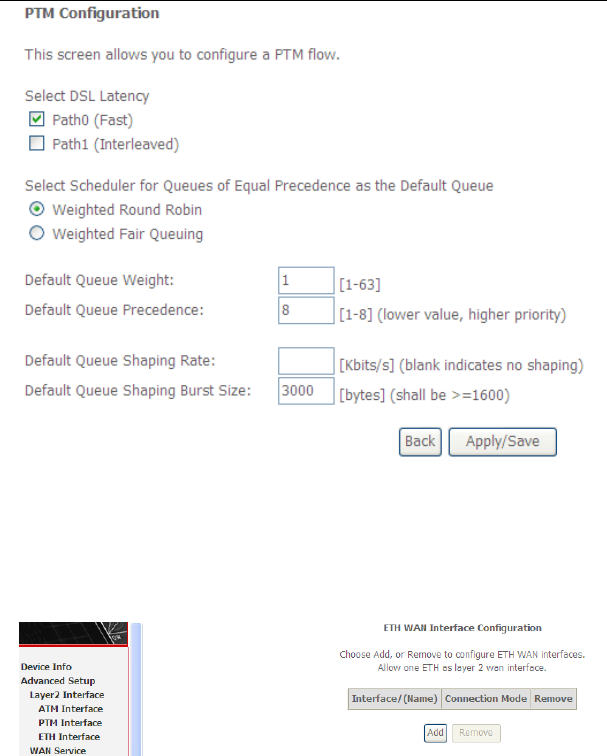
User Manual
25
In this page, you can select scheduler for queues of equal precedence and enter
the queue value. Click Apply/Save to save configuration.
5.2.1.3 ETH Interface
Choose Advanced Setup > Layer2 Interface > ETH Interface, and the following
page appears. In this page, you can add or remove to configure ETH WAN
Interfaces.
Click Add and the following page appears.
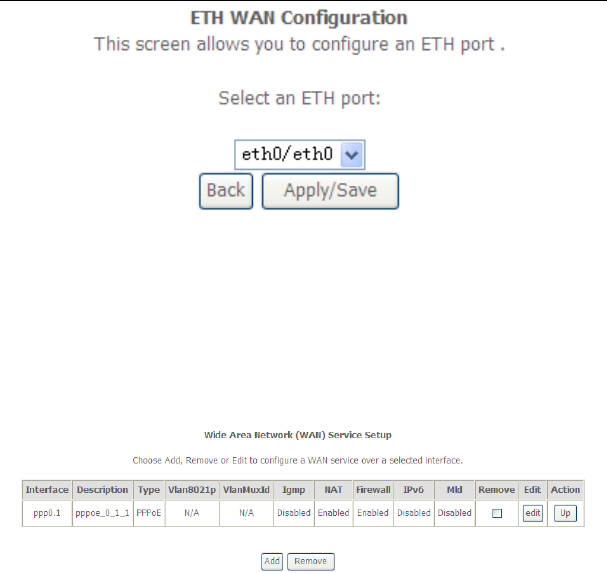
User Manual
26
In this page, you can select a ETH port. Click Apply/Save to save configuration.
Note:
If ETH Interface is selected, there are two WAN service types (PPPoE and
IPoE).
5.2.2 WAN Service
Choose Advanced Setup > WAN Service, and the following page appears.
In this page, you are allowed to add, remove, or edit a WAN service.
Note:
If PTM Interface is selected, there are three WAN service types: PPP over
Ethernet (PPPoE), IP over Ethernet, Bridging. And the corresponding
configurations of PTM WAN service are same as the configurations of ATM
WAN service.
5.2.2.1 Adding a PPPoE WAN Service
This section describes the steps for adding the PPPoE WAN service.

User Manual
27
Step1 In the Wide Area Network (WAN) Service Setup page, click the Add
button to display the following page. (At first, you must add a proper ATM
or PTM interface for this WAN service.)
Step2 In this page, you can select a ATM Interface for the WAN service. After
selecting the ATM interface, click Next to display the following page.
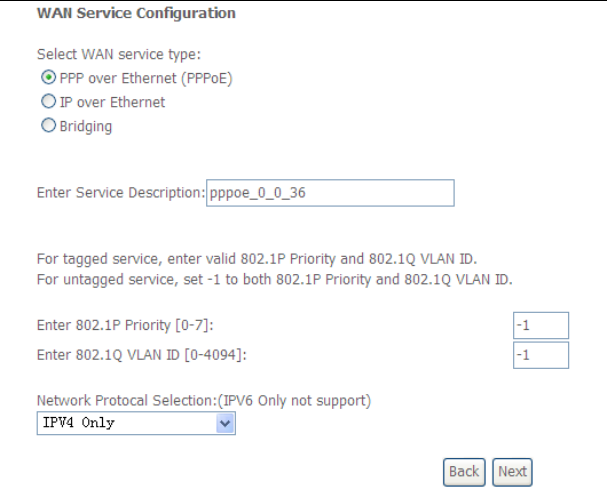
User Manual
28
Step3 In this page, select the WAN service type to be PPP over Ethernet
(PPPoE). Click Next to display the following page.
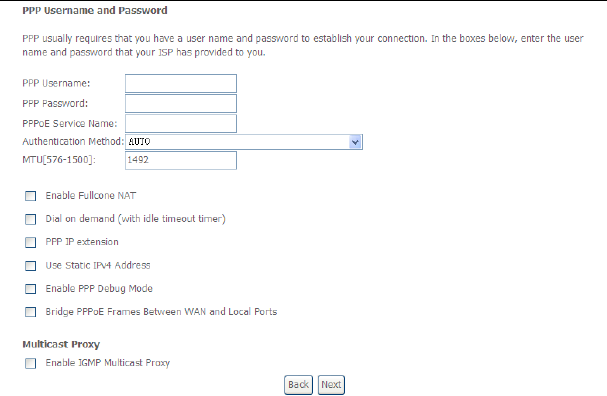
User Manual
29
Step4 In this page, you can modify the PPP username, PPP password, PPPoE
service name and authentication method.
PPP Username: The correct user name provided by your ISP.
PPP Password: The correct password provided by your ISP.
PPPoE Service Name: If your ISP provides it to you, please enter it. If not,
do not enter any information.
Authentication Method: The value can be AUTO, PAP, CHAP, or MSCHAP.
Usually, you can select AUTO.
Enable Fullcone NAT:. NAT is one where all requests from the same
internal IP address and port are mapped to the same external IP address
and port. Furthermore, any external host can send a packet to the internal
host, by sending a packet to the mapped external address.
Dial on demand (with idle timeout timer): If this function is enabled, you
need to enter the idle timeout time. Within the preset minutes, if the modem
does not detect the flow of the user continuously, the modem automatically
stops the PPPoE connection. Once it detects the flow (like access to a
webpage), the modem restarts the PPPoE dialup. If this function is disabled,
the modem performs PPPoE dial-up all the time. The PPPoE connnection

User Manual
30
does not stop, unless the modem is powered off and DSLAM or uplink
equipment is abnormal.
PPP IP extension: If you want to configure DMZ Host, you should enable it
first.
Use Static IPv4 Address: If this function is disabled, the modem obtains an
IP address assigned by an uplink equipment such as BAS, through PPPoE
dial-up. If this function is enabled, the modem uses this IP address as the
WAN IP address.
Enable PPP Debug Mode:Enable or disable this function.
Bridge PPPoE Frames Between WAN and Local Ports:Enable or disable
this function.
Enable IGMP Multicast Proxy:If you want PPPoE mode to support IPTV,
enable it.
Step5 After setting the parameters, click Next to display the following page.
Step6 In this page, select a preferred WAN interface as the system default
gateway and then click Next to display the following page.
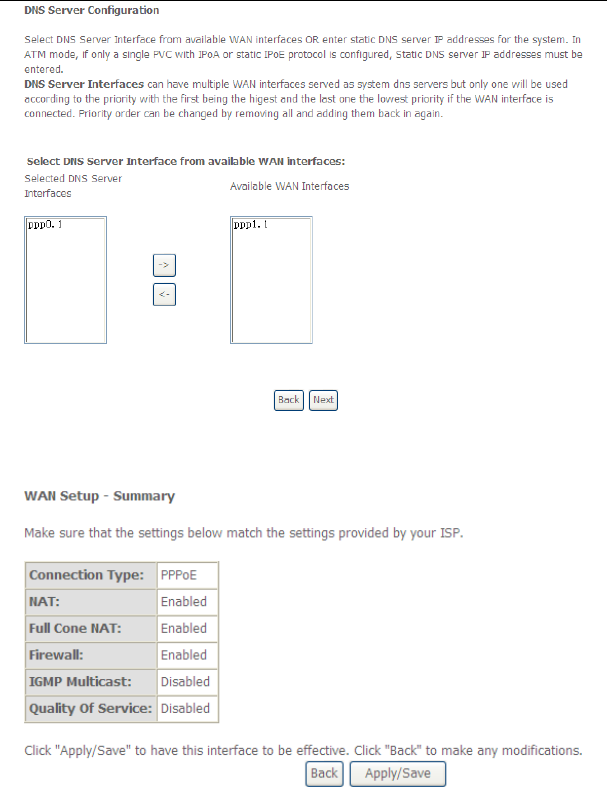
User Manual
31
Step7 In this page, you can obtain the DNS server addresses from the selected
WAN interface. Click Next, and the following page appears.
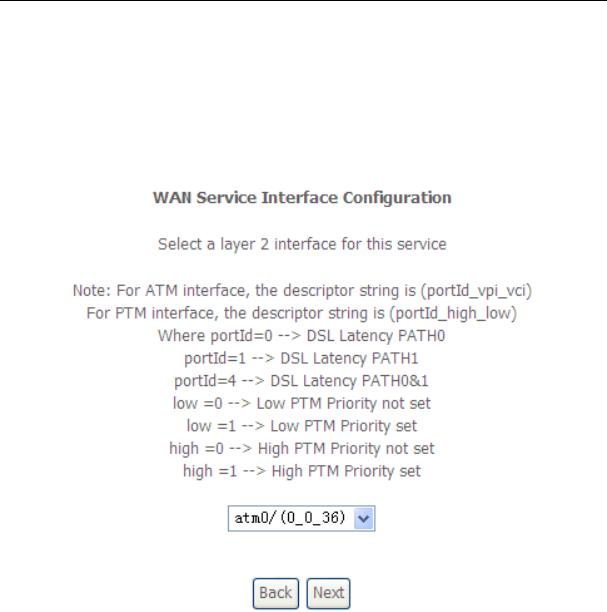
User Manual
32
Step8 In this page, it displays the information about the PPPoE settngs. Click
Apply/Save to save and apply the settings.
5.2.2.2 Adding a MER (IPoE) WAN service
This section describes the steps for adding the MER WAN service.
Step1 In the Wide Area Network (WAN) Service Setup page, click the Add
button to display the following page. (At first, you must add a ATM or PTM
interface for this WAN service.)
Step2 Select an ATM Interface, and then click Next to display the following
page.
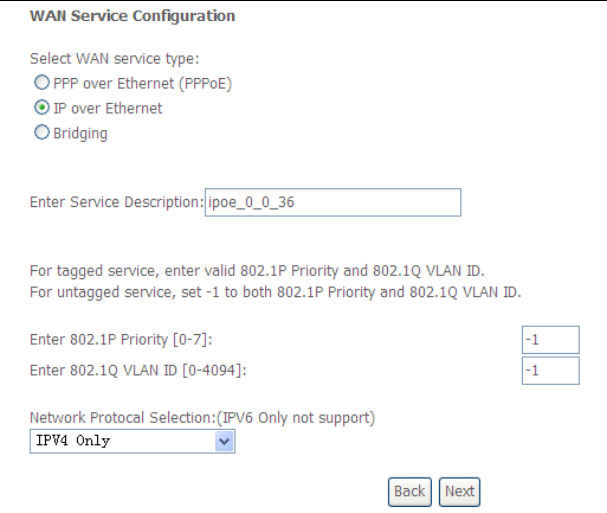
User Manual
33
Step3 In this page, select the WAN service type to be IP over Ethernet, enter
the service description for this service. After finishing setting, click Next to
display the following page.

User Manual
34
Step4 In this page, you may modify the WAN IP settings. You may select obtain
an IP address automatically or manually enter the IP address provided by
your ISP. Click Next and the following page appears.
Note:
If selecting Obtain an IP address automatically, DHCP will be enabled for PVC in
MER mode.
If selecting Use the following Static IP address, please enter the WAN IP address,
subnet mask and gateway IP address.
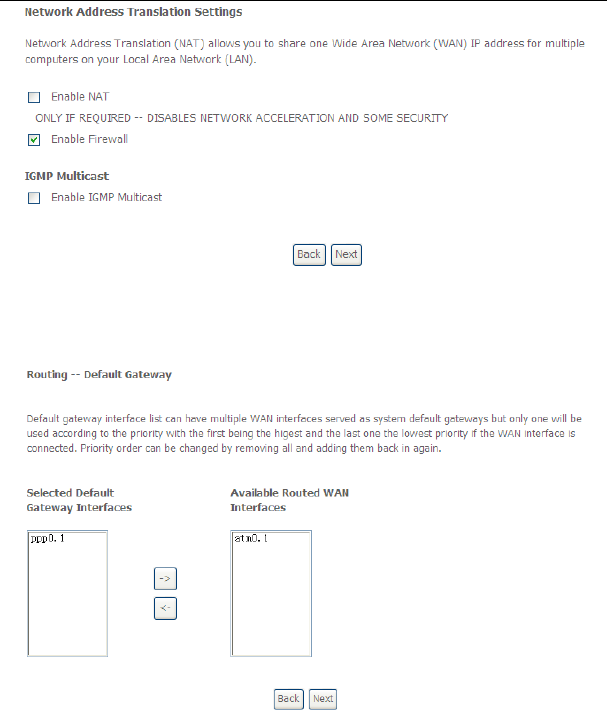
User Manual
35
Step5 In this page, you can set the network address translation settings,for
example, enabling NAT, enabling firewall, and enabling IGMP multicast.
After finishing setting, click Next and the following page appears.
Step6 In this page, select a preferred WAN interface as the system default
gateway and then click Next to display the following page.

User Manual
36
Step7 In this page, you can obtain the DNS server addresses from the selected
WAN interface. After finishing setting, click Next to display the following
page.

User Manual
37
Step8 In this page, it displays the information about the IPoE settngs.Click
Apply/Save to save and apply the settings.
5.2.2.3 Adding a PPPoA WAN service
This section describes the steps for adding the PPPoA WAN service.
Step1 Choose Advanced Setup > Layer2 Interface > ATM Interface to
dsipaly the DSL ATM Interface Configuration page. In this page, you
need to add a PVC for PPPoA mode. Click the Add button in the DSL
ATM Interface Configuration page to display the following page.
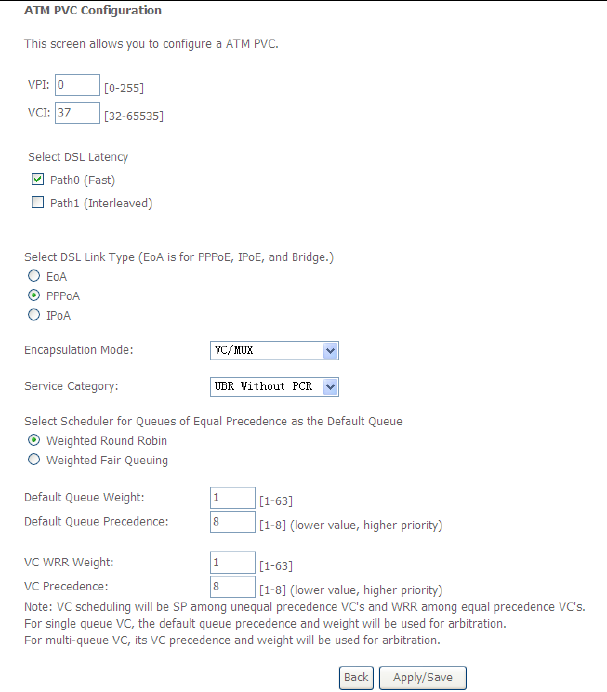
User Manual
38
Step2 Select the DSL link type to be PPPoA, and select the encapsulation
mode to be VC/MUX (according to the uplink equipment). After finishing
setting, click the Apply/Save button to apply the setings.
Step3 Choose WAN Service and click Add to display the following page.
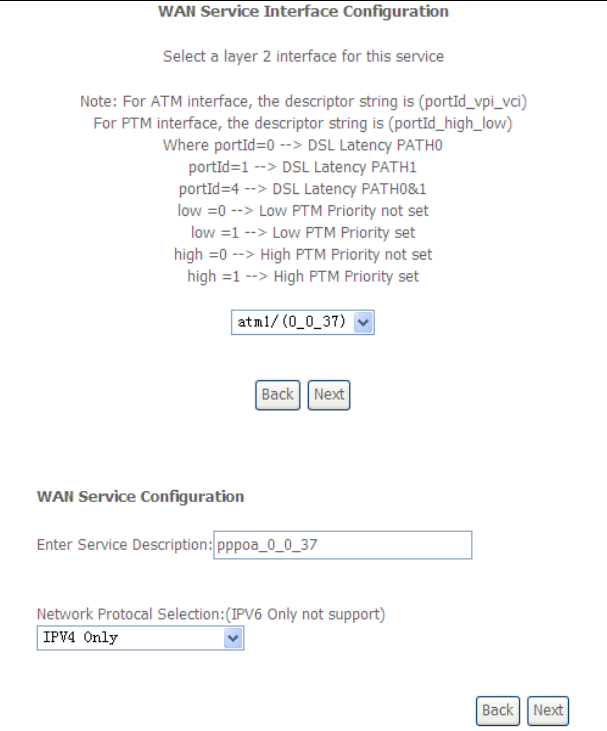
User Manual
39
Step4 Select the proper interface for the WAN service, and then click Next to
display the following page.
Step5 In this page, you may modify the service description. Click Next to
display the following page.
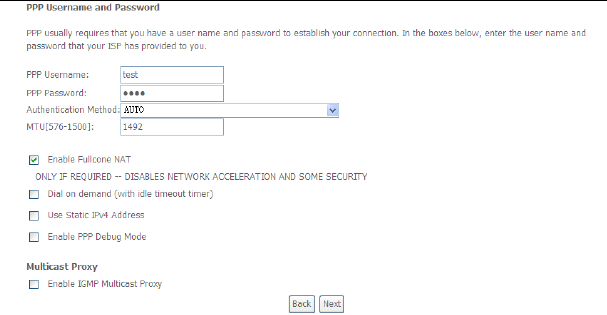
User Manual
40
PPP Username: The correct user name provided by your ISP.
PPP Password: The correct password provided by your ISP.
Authentication Method: The value can be AUTO, PAP, CHAP, or MSCHAP.
Usually, you can select AUTO.
Enable Fullcone NAT:. NAT is one where all requests from the same
internal IP address and port are mapped to the same external IP address
and port. Furthermore, any external host can send a packet to the internal
host, by sending a packet to the mapped external address.
Dial on demand (with idle timeout timer): If this function is enabled, you
need to enter the idle timeout time. Within the preset minutes, if the modem
does not detect the flow of the user continuously, the modem automatically
stops the PPPoA connection. Once it detects the flow (like access to a
webpage), the modem restarts the PPPoA dialup. If this function is disabled,
the modem performs PPPoA dial-up all the time. The PPPoA connnection
does not stop, unless the modem is powered off and DSLAM or uplink
equipment is abnormal.
PPP IP extension: If you want to configure DMZ Host, you should enable it
first.
Use Static IPv4 Address: If this function is disabled, the modem obtains an
IP address assigned by an uplink equipment such as BAS, through PPPoA

User Manual
41
dial-up. If this function is enabled, the modem uses this IP address as the
WAN IP address.
Enable PPP Debug Mode:Enable or disable this function.
Enable IGMP Multicast Proxy: If you want PPPoE mode to support IPTV,
enable it.
Step6 In this page, you can enter the PPP username and PPP password
provided by your ISP. Select the authentication method according to your
requirement. After finishing setting, click Next to display the following
page.
Step7 In this page, select a preferred WAN interface as the system default
gateway and then click Next to display the following page.
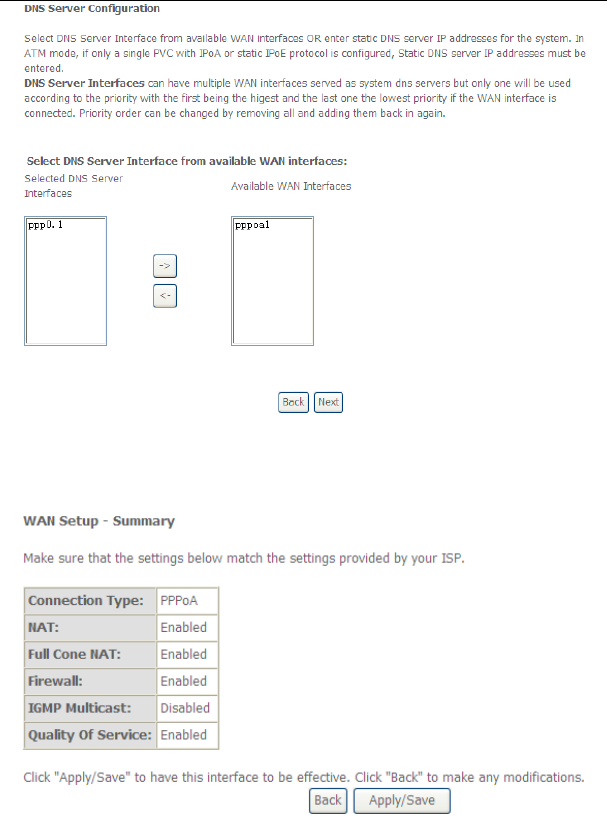
User Manual
42
Step8 In this page, you can obtain the DNS server addresses from the selected
WAN interface. After finishing setting, click Next to display the following
page.

User Manual
43
Step9 In this page, it displays the information about the PPPoA settngs.Click
Apply/Save to apply the settings. You can modify the settings by clicking
the Back button if necessary.
5.2.2.4 Adding an IPoA WAN service
This section describes the steps for adding the IPoA WAN service.
Step1 Choose Advanced Setup > Layer2 Interface > ATM Interface to
dsipaly the DSL ATM Interface Configuration page. In this page, you
need to add a PVC for IPoA mode. Click the Add button in the DSL ATM
Interface Configuration page to display the following page.
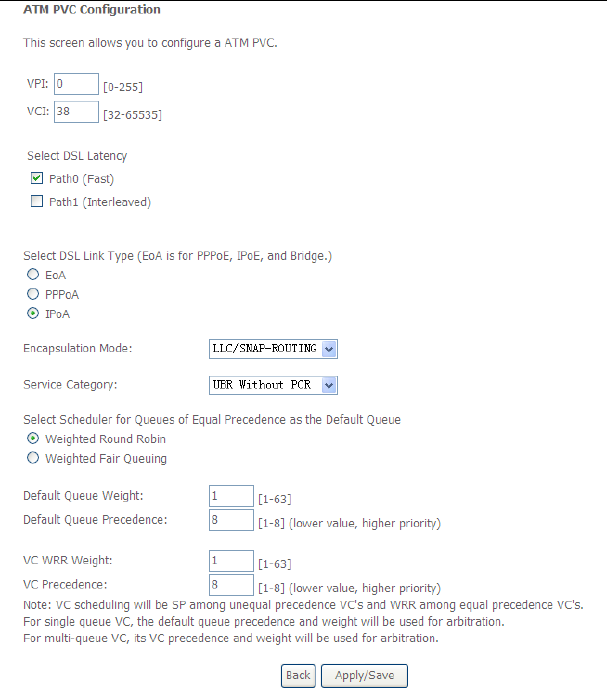
User Manual
44
Step2 Select the DSL link type to be IPoA, and select the encapsulation mode
to be LLC/SNAP-ROUTING (according to the uplink equipment). After
finishing setting, click the Apply/Save button to save the settings.
Step3 Choose WAN Service and click Add to display the following page.
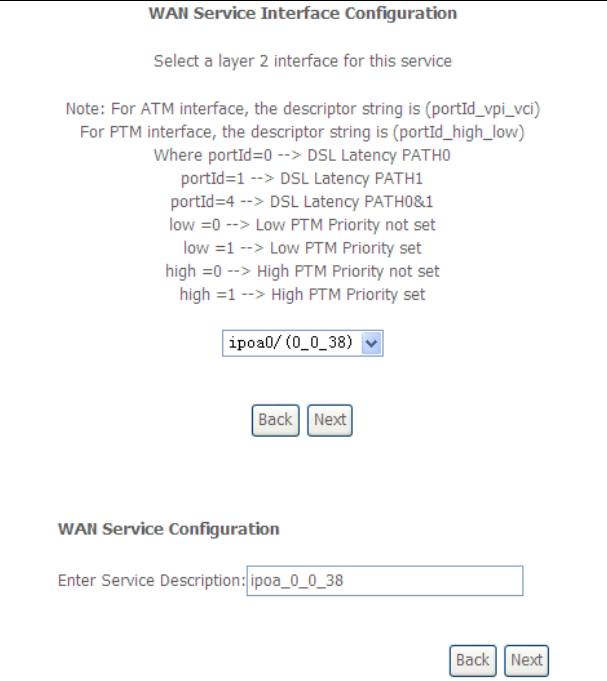
User Manual
45
Step4 Select the proper interface for the WAN service ,and then click Next to
display the following page.
Step5 In this page, you may modify the service description. Click Next to
display the following page.
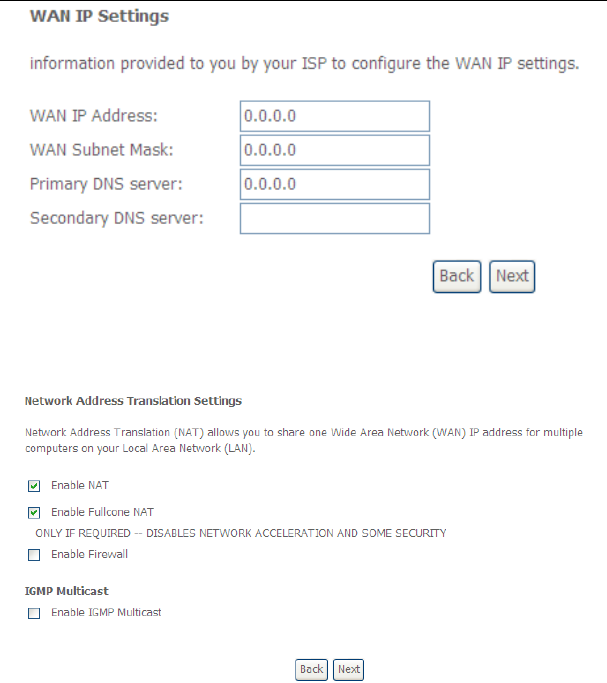
User Manual
46
Step6 In this page, enter the WAN IP address, the WAN subnet mask, and
primary DNS server provided by your ISP and then click Next to display
the following page.
In this page, Network Address Translation (NAT) allows you to share one Wide
Area Network (WAN) IP address for multiple computers on your Local Area
Network (LAN).
If you do not want to enable NAT, and wish the user of modem to access the
Internet normally, you need to add a route on the uplink equipment. Otherwise, the
access to the Internet fails. Normally, please enable the NAT function.
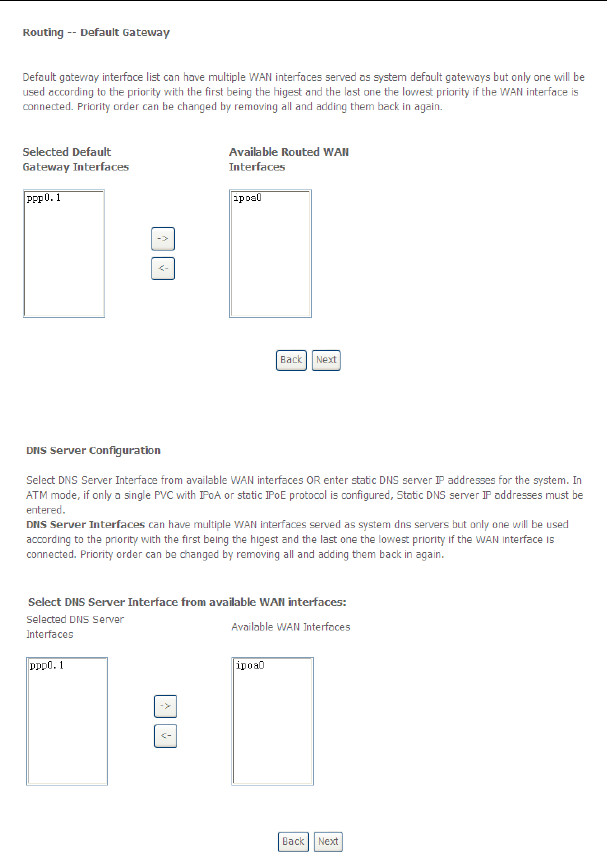
User Manual
47
Step7 After finishing setting, click Next to display the following page.
Step8 In this page, select a preferred WAN interface as the system default
gateway and then click Next to display the following page.

User Manual
48
Step9 In this page, you can obtain the DNS server addresses from the selected
WAN interface. After finishing setting, click Next to display the following
page.
Step10 In this page, it displays the information about the IPoA settngs. Click
Apply/Save to save and apply the settings. You can modify the settings
by clicking the Back button if necessary.
5.2.2.5 Adding a Bridge WAN service
This section describes the steps for adding the Bridge WAN service.
Step1 In the Wide Area Network (WAN) Service Setup page, click the Add
button to display the following page. (At first, you must add a proper ATM
or PTM interface for this WAN service.) Click the Add button to display
the following page.
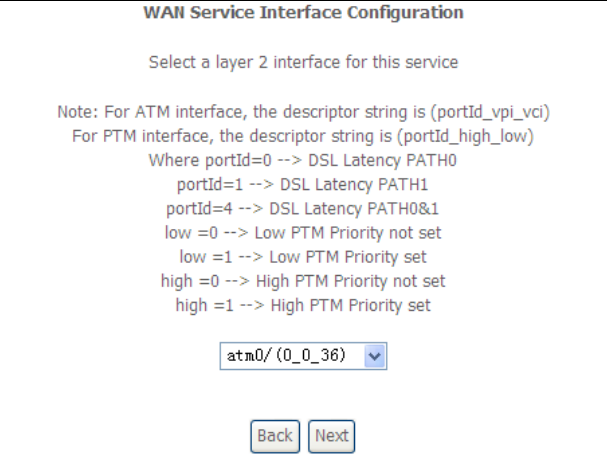
User Manual
49
Step2 Select the proper ATM Interface and then click Next to display the
following page.
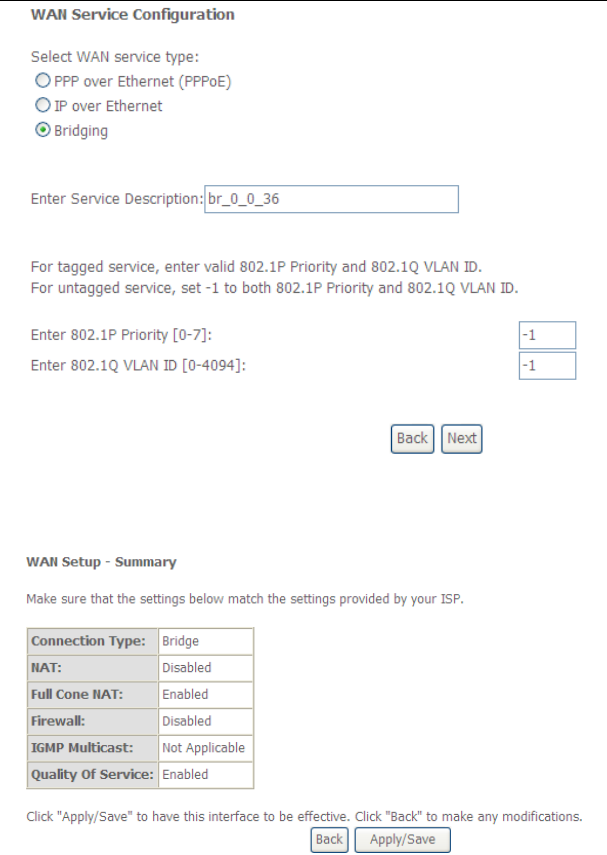
User Manual
50
Step3 In this page, you can select the WAN service type, and modify the service
description for this service. After finishing setting, click Next to display the
following page.

User Manual
51
Step4 In this page, it displays the information about the bridge settngs. Click
Apply/Save to save and apply the settings. You can modify the settings
by clicking the Back button if necessary.
5.2.3 3G WAN Service
Choose Advanced Setup > 3G WAN Service , and the following page appears.
This page is used to configure 3G connection. If you want to access the Internet
through 3G connection, a 3G network card is required. Connect the 3G network card
to the USB interface of the Router.
Information: Click it to display the information of the 3G network card.
Pin Manage: Click it to configure the 3G PIN.
Upload Driver: For a un-support USB dongle, click it to upload the new
driver for supporting the USB. The driver is a text file.
Click Pin Manage, and the following page appears.
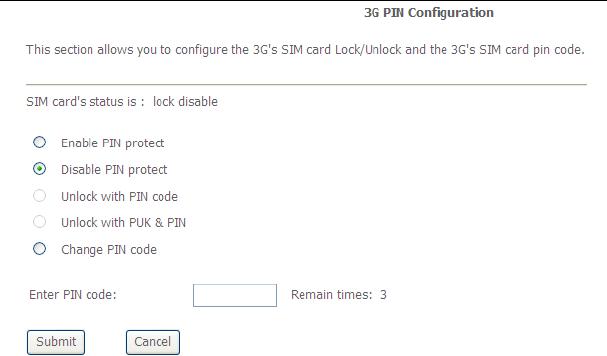
User Manual
52
Enable PIN protect: If you enable it, you need to enter the PIN code when
rebooting or inserting the card to the USB interface.
Unlock with PIN code: If you disable it, you need to enter PIN code when
using 3G.
Unlock with PUK & PIN: If you disable it, you need to enter PUK code when
failing to enter the PIN code for 3 times.
Change PIN code: Choose it to change the PIN code.
After proper settings, click Submit to take the settings in to effect.
Click Add in the WAN Service For 3G Moblie Setup to display the following page.
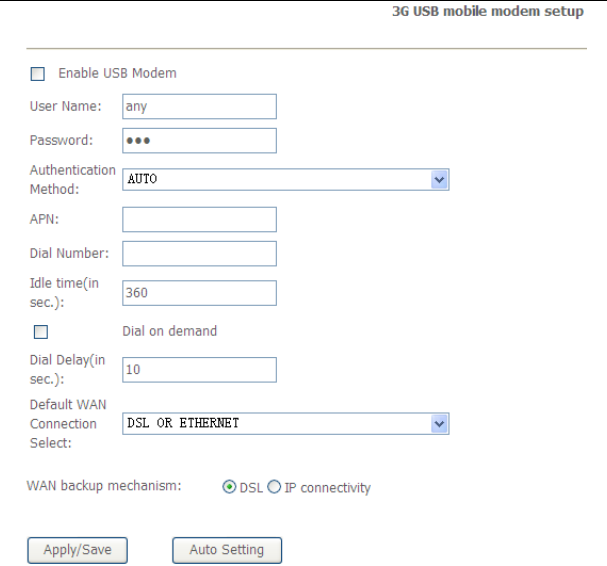
User Manual
53
In this page, you are allowed to configure the settings of the 3G USB modem.
Enable USB Modem: If you want to access the Internet through the 3G
network card, you must enable the USB modem.
User Name: Username provided by your 3G ISP.
Password: Password provided by your 3G ISP.
Authentication Method: Select a proper authentication method in the drop-
down list. You can select Auto, PAP, CHAP, or MSCHAP.
APN: APN (Access Point Name) is used to identify the service type. Enter
the APN provided by your 3G ISP.
Dial Number: Enter the dial number provided by your 3G ISP.
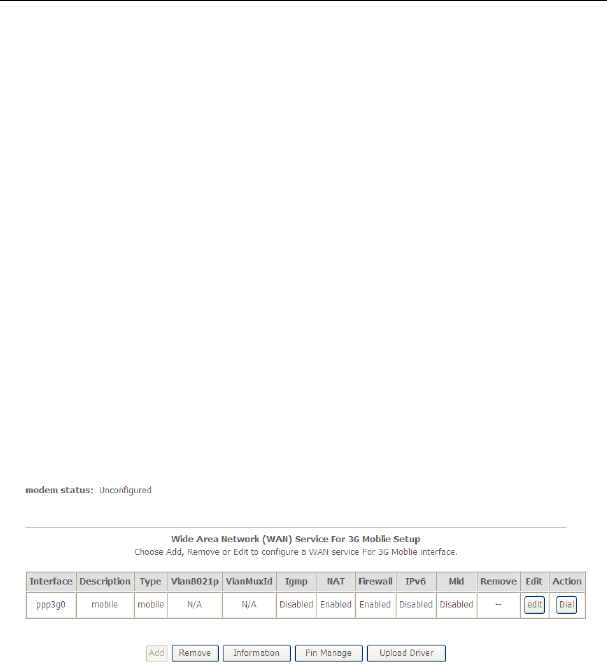
User Manual
54
Idle time (in sec.): If no traffic for the preset time, the 3G will disconnect
automatically.
Net Select: Select the 3G network that is available.You may select EVDO,
WCDMA, CDMA2000, TD-SCDMA, GSM, or Auto.
Dial on demand: Within the preset minutes, if the modem does not detect
the flow of the user continuously, the modem automatically stops the 3G
connection. Once it detects the flow (like access to a webpage), the modem
restarts the 3G dialup.
Dail Delay (in sec.): The 3G delays dial after the DSL is disconnected.
Default WAN Connection Select: You can select DSL or 3G from the
drop-down list.
WAN back mechanism: The 3G connection is backup for the DSL
connection.
– DSL: If the DSL is disconnected, the 3G starts to dial.
– IP connectivity: If the system fails to ping the specified IP address, the
3G starts to dial.
After finishing setting, click the Apply/Save button to save the settings.
You may also click the auto setting button to automatically configure the 3G
connection.
After clicking the Apply/Save button, the following page appears.
If the 3G network card is installed, you may click the button on the Action column to
establish or disconnect the 3G connection.
Note:
When there is no DSL WAN connection, insert the 3G network card, and then
system will perform dial-up automatically. If the DSL WAN connection and the
3G connection coexist, the DSL WAN connection takes priority over the 3G
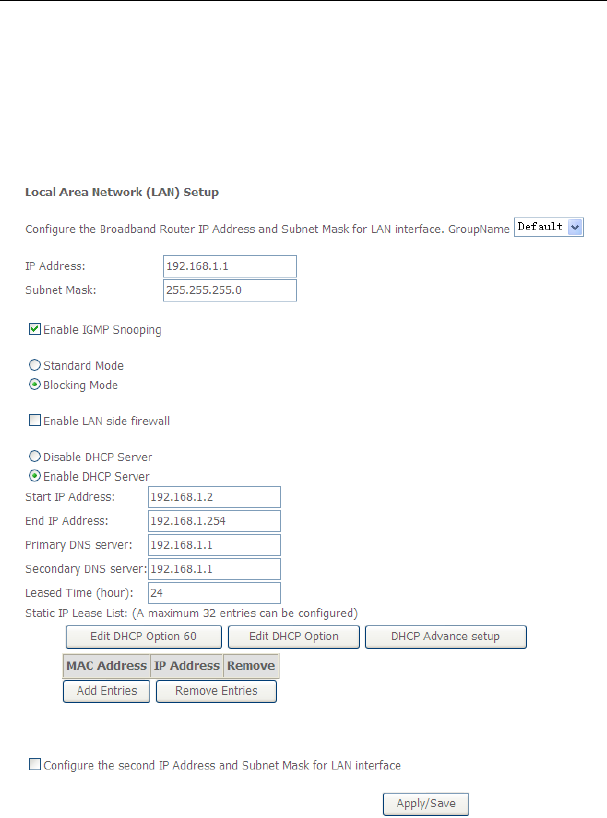
User Manual
55
connection. When the DSL WAN connection starts to perform dial-up, the 3G
connection will be disconnected. If the DSL WAN connection has established,
you may manually to perform 3G dial-up, and then the DSL WAN connection
will be disconnected.
5.2.4 LAN Configuration
Choose Advanced Setup > LAN, and the following page appears.

User Manual
56
In this page, you can configure an IP address for the DSL router, enable IGMP
snooping, enable or disable the DHCP server, edit the DHCP option, configure the
DHCP advanced setup and set the binding between a MAC address and an IP
address.
Configuring the Private IP Address for the DSL Router
In this page, you can modify the IP address of the device. The preset IP address is
192.168.1.1.
Enabling IGMP Snooping
IGMP snooping enables the router to forward multicast traffic intelligently, instead of
flooding all ports in the VLAN. With IGMP snooping, the router listens to IGMP
membership reports, queries and leave messages to identify the switch ports that are
members of multicast groups. Multicast traffic will only be forwarded to ports identified
as members of the specific multicast group or groups.
Enabling the LAN Side Firewall
Firewall can prevent unexpected traffic on the Internet from your host in the LAN.
In this page, you can enable or disable the LAN side firewall.
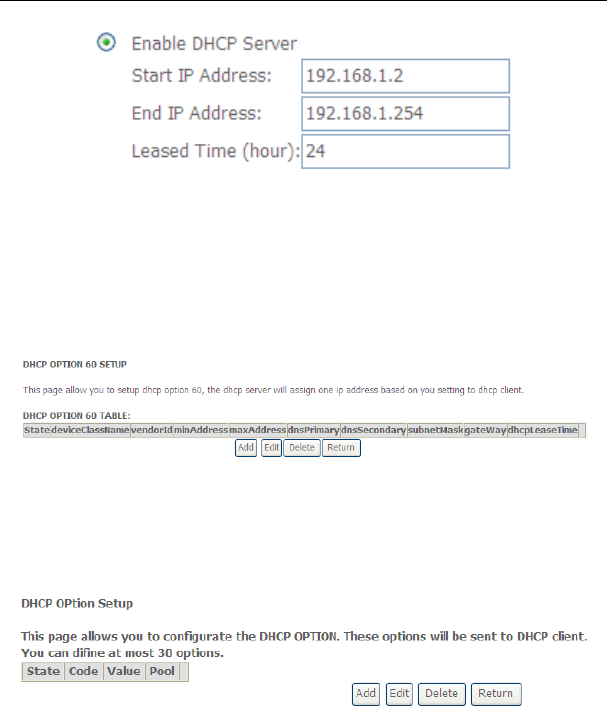
User Manual
57
Configuring the DHCP Server
If you enable the DHCP sever, the clients will automatically acquire the IP address
from the DHCP server. If the DHCP server is disabled, you need to manually set the
start IP address, end IP address and the lease time for the clients in the LAN.
Editing the DHCP Option60
Click the Edit DHCP Option60 button in the Local Area Network (LAN) Setup page
to display the DHCP Option60 Setup page.
In this page, you can add, edit or delete the DHCP60 options.
Editing the DHCP Option
Click the Edit DHCP Option button in the Local Area Network (LAN) Setup page to
display the DHCP Option Setup page.
In this page, you can add, edit or delete the DHCP options, and these options will be
sent to the DHCP client.

User Manual
58
DHCP Advanced Setup
Click the DHCP Advance Setup button in the Local Area Network (LAN) Setup
page to display the following page. In this page, you can enable or disable DHCP for
every LAN interface.
Configuring the DHCP Static IP Lease List
The lease list of static IP address can reserve the static IP addresses for the hosts
with the specific MAC addresses. When a host whose MAC address is in the lease
list of static IP address requests the DHCP server for an IP address, the DHCP server
assigns the reserved IP address to the host.
Click the Add Entries button in the Local Area Network (LAN) Setup page to
display the DHCP Static IP Lease page.

User Manual
59
In this page, enter the MAC address of the LAN host and the static IP address that
is reserved for the host, and then click the Apply/Save button to apply the settings.
Configuring the Second IP Address and Subnet Mask for a LAN
Interface
In the Local Area Network (LAN) Setup page, you are allowed to set the second IP
address and the subnet mask for a LAN interface.
After enabling Configure the second IP Address and Subnet Mask for LAN
interface, enter an IP address and a subnet mask for the LAN interface.
After finishing setting, click the Apply/Save button to apply the settings.
5.2.4.1 IPv6 Auto-configuration
Click Advanced Setup > LAN >IPv6 Autoconfig, and the following page appears.

User Manual
60
In this page, you can set an IP address for the DSL IPv6 router, enable the
DHCPv6 server, enable RADVD and enable the MLD snooping function.
Enable DHCPv6 Server: WIDE-DHCPv6 is an open-source implementation
of dynamic host configuration protocol for IPv6 (DHCPv6) originally
developed by the KAME project. The implementation mainly complies with
the following standards: RFC3315, RFC3319, RFC3633, RFC3646,
RFC4075, RFC 4272 etc.
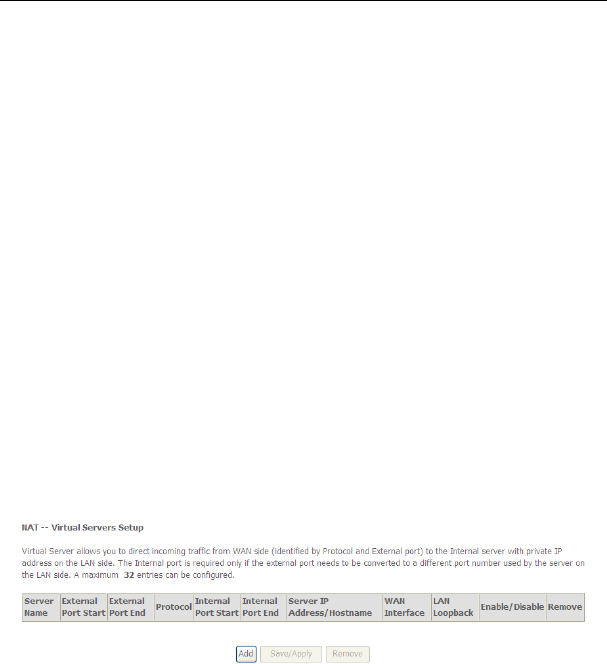
User Manual
61
Enable RADVD: The router advertisement daemon (RADVD) is run by Linux
or BSD systems acting as IPv6 routers. It sends router advertisement
messages, specified by RFC2461, to a local Ethernet LAN periodically and
when requested by a node sending a router solicitation message. These
messages are required for IPv6 stateless auto-configuration.
Enable MLD Snooping: Multicast Listener Discovery Snooping (MLD
Snooping) is an IPv6 multicast constraining mechanism that runs on Layer 2
devices to manage and control IPv6 multicast groups. By analyzing received
MLD messages, a Layer 2 device running MLD Snooping establishes
mappings between ports and multicast MAC addresses and forwards IPv6
multicast data based on these mappings.
After finishing setting, click the Save/Apply button to apply the settings.
5.2.5 NAT
5.2.5.1 Virtual Servers
Firewall can prevent unexpected traffic on the Internet from your host on the LAN.
The virtual server can create a channel that can pass through the firewall. In that
case, the host on the Internet can communicate with a host on your LAN within
certain port range.
Choose Advanced Setup > NAT > Virtual Servers, and the following page
appears.
In this page, you are allowed to add or remove a virtual server entry.
To add a virtual server, do as follows:
Step 1 Click the Add button to display the following page.
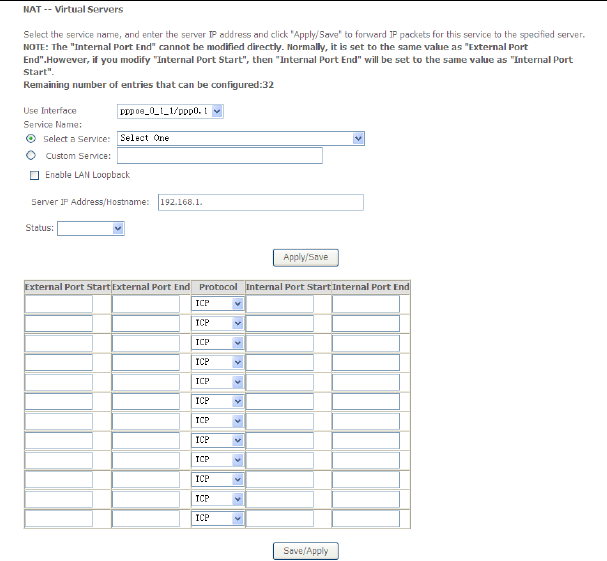
User Manual
62
Use interface: Select an interface that you want to configure.
Select a Service: Select a proper service in the drop-down list.
Custom Server: Enter a new service name to establish a user service type.
Server IP Address: Assign an IP address to virtual server.
External Port Start: When selecting a service, the port number will
automatically be displayed. You can modify it if necessary.
External Port End: When selecting a service, the port number will
automatically be displayed. You can modify it if necessary.
Protocol: You may select TCP/UDP, TCP, or UDP in the drop-down list.
Internal Port Start: When selecting a service, the port number will
automatically be displayed. You can modify it if necessary.
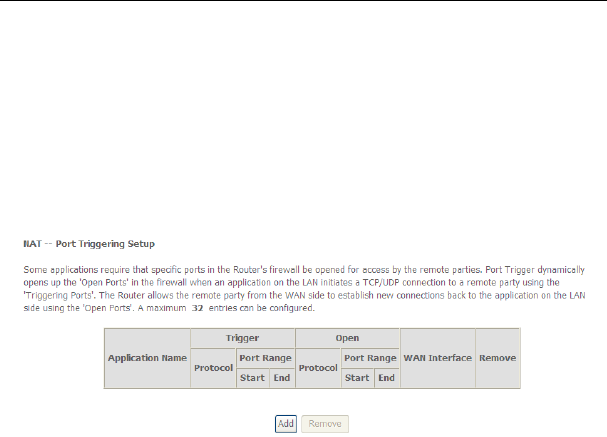
User Manual
63
Internal Port End: When selecting a service, the port number will
automatically be displayed. You can modify it if necessary.
Step 2 After finishing setting, click Save/Apply to save and apply the settings.
5.2.5.2 Port Triggering
Some applications need some ports to be opened in the firewall for the remote
access. When an application initializes a TCP/UDP to connect to a remote user,
port triggering dynamically opens the open ports of the firewall.
Choose Advanced Settings > NAT > Port Triggering, and the following page
appears.
In this page, you may add or remove an entry of port triggering.
Click the Add button to display the following page.
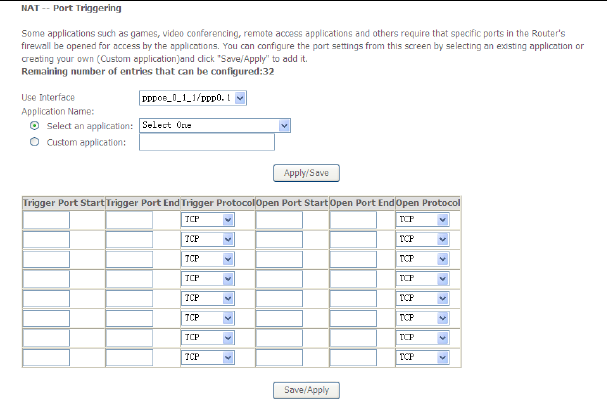
User Manual
64
Use interface: Select an interface that you want to configure.
Select an application: Select a proper application in the drop-down list.
Custom application: Manually define an application.
Trigger port Start: The start port number that LAN uses to trigger the open
port.
Trigger port End: The end port number that LAN uses to trigger the open
port.
Trigger Protocol: Select the application protocol. You may select TCP/UDP,
TCP, o r U DP.
Open Port Start: The start port number that is opened to WAN.
Open Port End: The end port number that is opened to WAN.
Open Protocol: Select the proper protocol that is opened to WAN. You may
select TCP/UDP, TCP, or UDP.
After finishing setting, click Save/Apply to apply the settings.
Note:

User Manual
65
You can use a single port number, several port numbers separated by commas,
port blocks consisting of two port numbers separated by a dash, or any
combination of these, for example 80, 90-140, 180.
5.2.5.3 DMZ Host
DMZ allows all the ports of a PC on your LAN to be exposed to the Internet. Set the
IP address of the PC to be DMZ host, so that the DMZ host will not be blocked by
firewall.
Choose Advanced Setup > NAT > DMZ host to display the following page.
In this page, enter the IP address of the DMZ host.
After finishing the settings, click the Apply/Save button to apply the settings.
If you want to clear the DMZ function of the host, please delete the IP address of
the host in the field of DMZ Host IP Address, and then click the Apply/Save
button.
5.2.6 Security
Firewall
Choose Security > Firewall and the following page appears.
Click Modify Firewall or Remove Firewall to modify or remove the firewall. And
click Modify Rule or Remove Rule to modify or remove the rule.

User Manual
66
Click Add Firewall, and the following page appears.
name: The name of firewall.
interface: You can select LAN or WAN from the drop-down list.
type: You can select IN or OUT from the drop-down list.
defaultaction: You can select Permit or Drop from the drop-down list.
Click Add Rule, and the following page appears.
enabled: Select the check box to enable the firewall rule.
Protocol: You can select UDP, TCP, or ICMP from the drop-down list.
Action: You can select Permit, Drop, or Reject from the drop-down list.
RejectType: You can select the reject type, when you select Reject as the
action.
IcmpType: You can select the type of ICMP packet, when you select ICMP
as the protocol.
origIPAddress: The original IP address.
origMask: The original subnet mask.
origStartPort: The original start port.
origEndPort: The original end port.
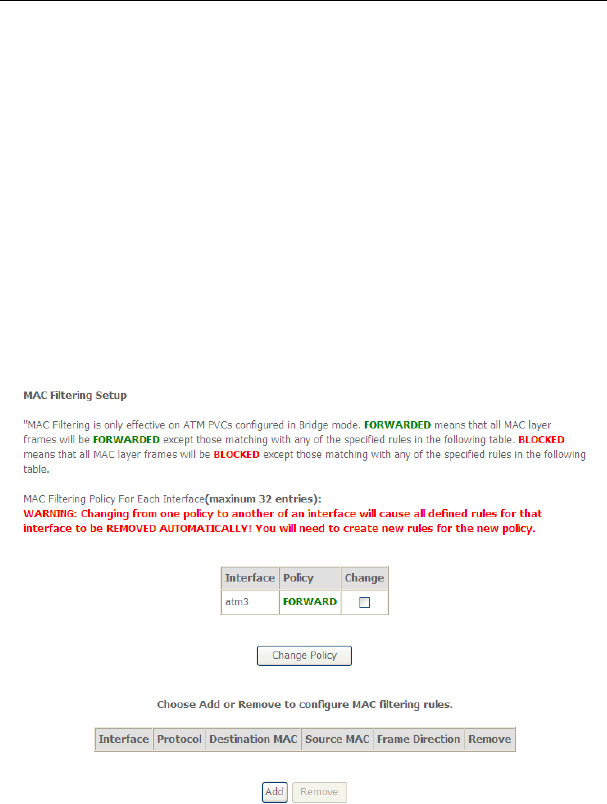
User Manual
67
destIPAddress: The destination IP address.
destMask: The destination subnet mask.
destStartPort: The destination start port.
destEndPort: The destination end port.
After finishing setting, click Save&Apply to save and activate the rule.
MAC Filtering Setup
In some cases, you may want to manage Layer2 MAC address to block or permit a
computer within the home network. When you enable MAC filter rules, the DSL
router serves as a firewall that works at layer 2.
Note:
MAC filtering is only effective on ATM PVCs configured in bridge mode.
Choose Security > MAC Filtering and the following page appears.

User Manual
68
In this page, you can add or remove the MAC filtering rule. You may change the MAC
filtering policy from FORWARDED to BLOCKED by clicking the Change Policy
button.
Click the Add button to display the following page.
Protocol Type: Select the proper protocol type.
Destination MAC Address: Enter the destination MAC address.
Source MAC Address: Enter the source MAC address.
Frame Direction: The direction of transmission frame.
WAN Interface (Configured in bridge mode only): Select the proper WAN
interface in the drop-down list.
After finishing setting, click Apply/Save to save and apply the filtering rule.
5.2.7 Parental Control
Time Restriction
Choose Advanced Setup > Parental Control > Time Restriction, and the
following page appears.
Click the Add button to display the following page.

User Manual
69
This page is used to control the time restriction to a special LAN device that
connects to the DSL router. In this page, se the user name and configure the time
settings.
After finishing setting, click the Apply/Save button to save and apply the settings.
Url Filter
Click Advanced Setup > Parental Control > Url Filter, and the following page
appears.
Thisp age is used to prevent the LAN users from accessing some Websites in the
WAN.
In this page, you may select the Exclude URL list type or the Include URL list type.
If you select the Exclude URL list type, it means that the URLs in the list are not
accessible. If you select the select the Include URL list type, you are allowed to
access the the URLs in the list.
Click the Add button to display the following page.

User Manual
70
In this page, enter the URL address and its corresponding port number. For
example, enter the URL address http://www.google.com and the port number 80,
and then click the Apply/Save button. See the following figure:
5.2.8 Quality of Service
Enabling QoS
Choose Advance Setup > Quality of Service and the following page appears.
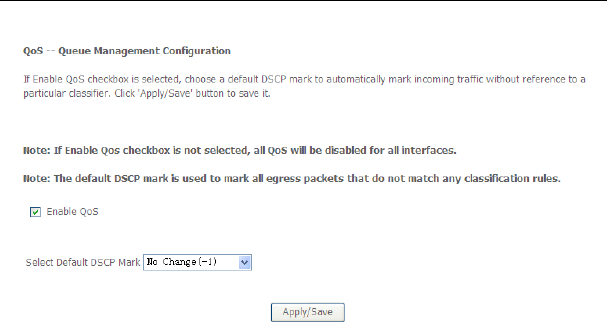
User Manual
71
Select Enable QoS to enable QoS and configure the default DSCP mark.
In this page, enable the QoS function and select the default DSCP mark.
After finishing setting, click Apply/Save to save and apply the settings.
Note:
If the Enable Qos checkbox is not selected, all QoS will be disabled for all
interfaces. The default DSCP mark is used to mark all egress packets that do
not match any classification rules.
Queue Configuration
Choose Advanced Setup > Quality of Service > QoS Queue, and the following
page appears.
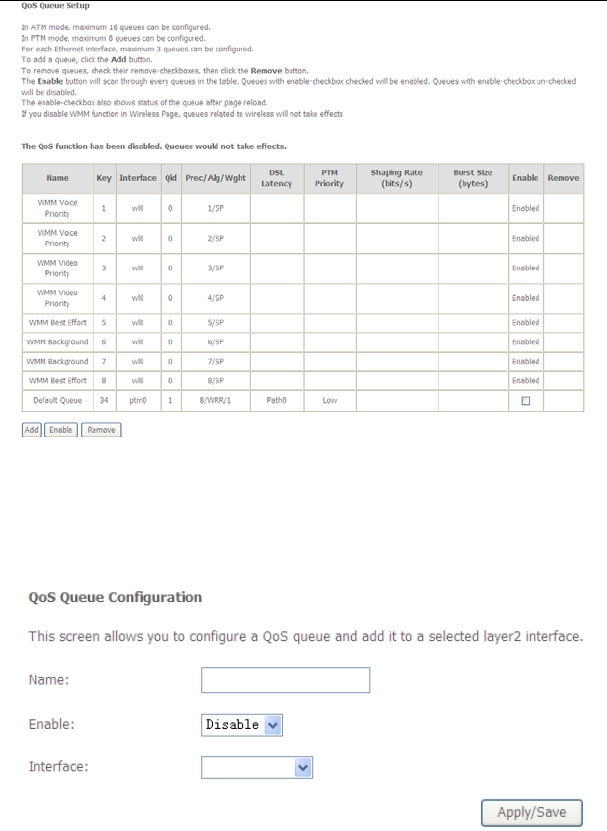
User Manual
72
In this page, you can enable, add or remove a QoS rule.
Note:
The lower integer value for precedence indicates the higher priority.
Click the Add button to display the following page.
Name: Enter the name of QoS queue.
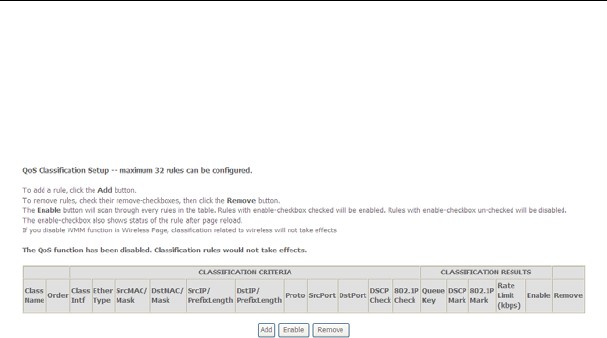
User Manual
73
Enable: Enable or disable the QoS queue.
Interface: Select the proper interface for the QoS queue.
After finishing setting, click Apply/Save to save and apply the settings.
QoS Classification
Choose Advanced Setup > Quality of Service > Qos Classification and the
following page appears.
In this page, you can enable, add or remove a QoS classification rule.
Click the Add button to display the following page.
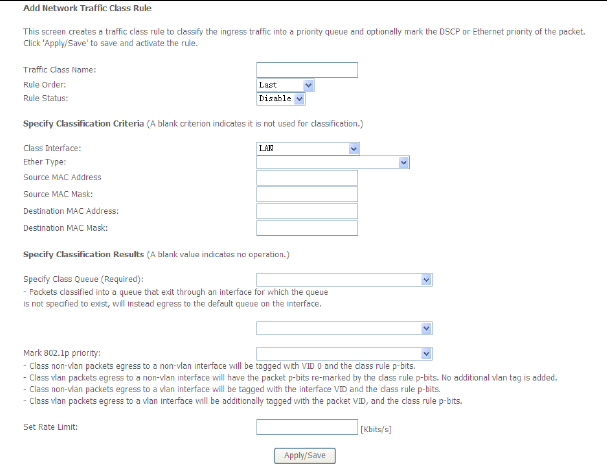
User Manual
74
5.2.9 Routing
Default Gateway
Choose Advanced Setup > Routing > Default Gateway, and the following page
appears.

User Manual
75
In this page, you can modify the default gateway settings.
Select a proper WAN interface in the drop-down list of Selected WAN Interface as
the system default gateway.
After finishing setting, click Apply/Save to save and apply the settings.
Static Route
Choose Advanced Setup > Routing > Static Route and the following page
appears.
In this page, you can add or remove a static routing rule.
Click the Add button to display the following page.
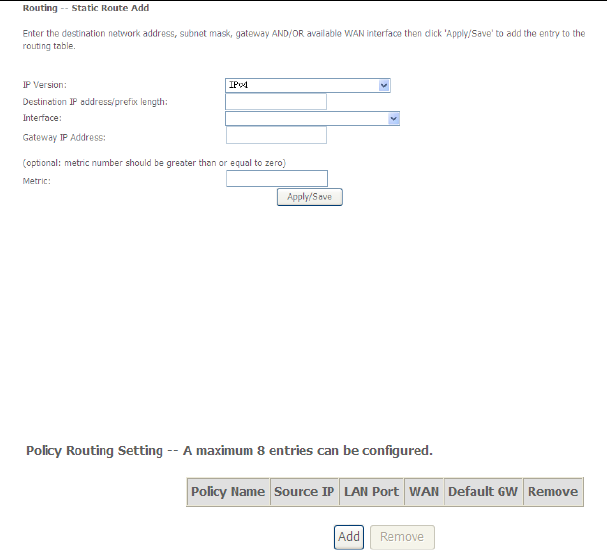
User Manual
76
IP Version: Select the IP version.
Destination IP address/prefix length: Enter the destination IP address.
Interface: select the proper interface for the rule.
Gateway IP Address: The next-hop IP address.
Metric: The metric value of routing.
After finishing setting, click Apply/Save to save and apply the settings.
Policy Routing
Choose Advanced Setup > Routing > Policy Routing and the following page
appears.
In this page, you can add or remove a static policy rule.
Click the Add button to display the following page.
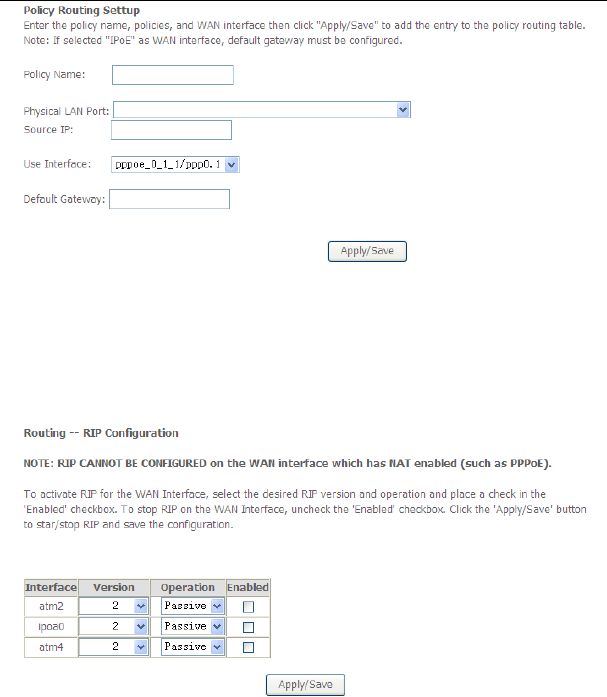
User Manual
77
In this page, enter the policy name, source IP and default gateway, and select the
physical LAN port and interface.
After finishing setting, click Apply/Save to save and apply the settings.
RIP
Choose Advanced Setup > Routing > RIP and the following page appears.
In this page, if you want to configure an individual interface, select the desired RIP
version and operation, and then select the Enabled checkbox for the interface.
After finishing setting, click Apply/Save to save and apply the settings.
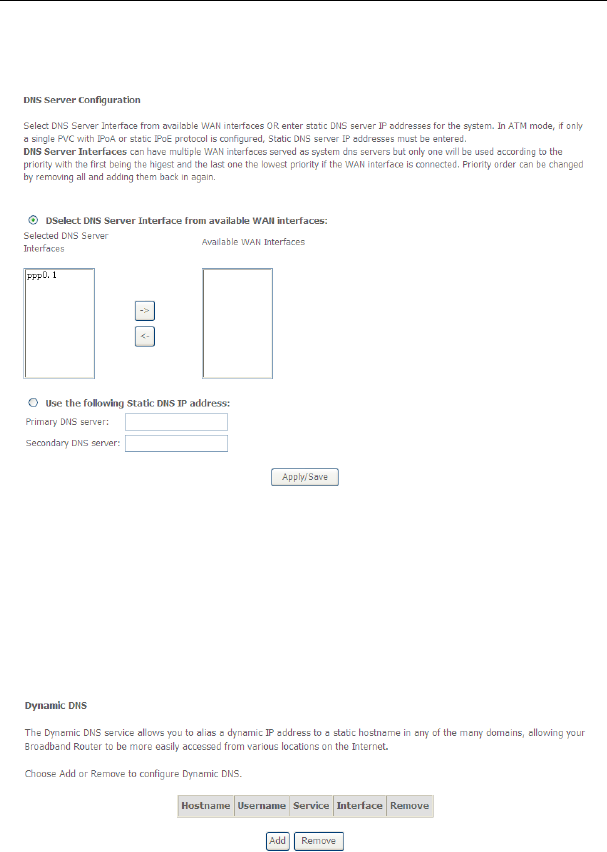
User Manual
78
5.2.10 DNS
DNS Server
Choose Advanced Setup > DNS > DNS Server and the following page appears.
In this page, you can select a DNS server interface from the available interfaces,
manually enter the DNS server addresses, or obtain the DNS address from a WAN
interface.
After finishing setting, click Apply/Save to save and apply the settings.
Dynamic DNS
Choose Advanced Setup > DNS > Dynamic DNS and the following page
appears.

User Manual
79
In this page, you are allowed to modify the DDNS settings.
Click the Add button to display the following page.
D-DNS provider: Select a proper DDNS server in the drop-down list.
Hostname: It is the domain name and it can be modified.
Interface: The interface that the packets pass through on the DSL router.
Username: Enter the username for accessing the DDNS management
interface.
Password: Enter the password for accessing the DDNS management
interface.
After finishing setting, click Apply/Save to save and apply the settings.
5.2.11 DSL
Choose Advanced Setup > DSL and the following page appears. In this page, you
can view the DSL settings. Usually, you can keep this factory default setting. The
modem negotiates the modulation mode with the DSLAM. If you select VDSL2
Enabled check box, you can set the VDSL2 parameters on the right area.

User Manual
80
In this page, you can set the DSL settings. Usually, you do not need to modify the
factory default settings.
After finishing setting, click Apply/Save to save and apply the settings.
5.2.12 UPnP
Choose Advanced Setup > UPnP and the following page appears.
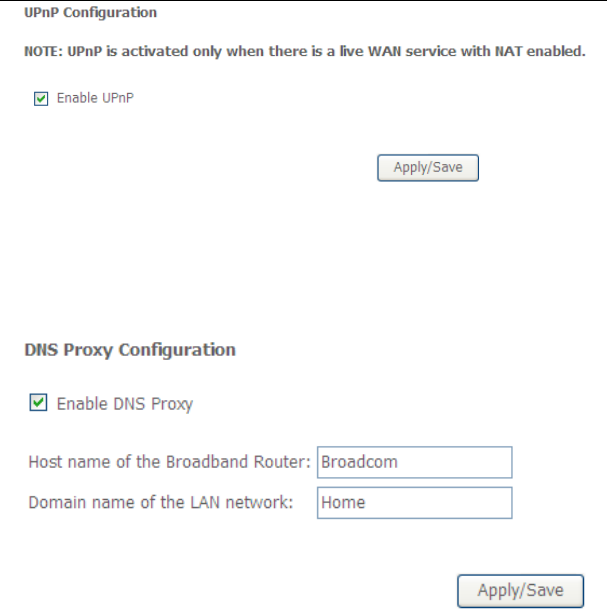
User Manual
81
In this page, you can enable or disable the UPnP function.
After finishing setting, click Apply/Save to save and apply the settings.
5.2.13 DNS Proxy
Choose Advanced Setup > DNS Proxy and the following page appears.
In this page, you can enable or disable the DNS proxy function.
After enabling the DNS proxy function, enter the host name of the broadband
router and the domain name of the LAN network, and then click Apply/Save to
save and apply the settings.
5.2.14 Print Server
Choose Advanced Setup > Printer Server and the following page appears.

User Manual
82
In this page, you can enable or disable the printer server.
After finishing setting, click Apply/Save to save and apply the settings.
5.2.15 DLNA
Choose Advanced Setup > DLNA and the following page appears.
In this page, select the Enable on-board digital media server check box, and the
following page appears. In this page, enter the media library path to run digital
media server.
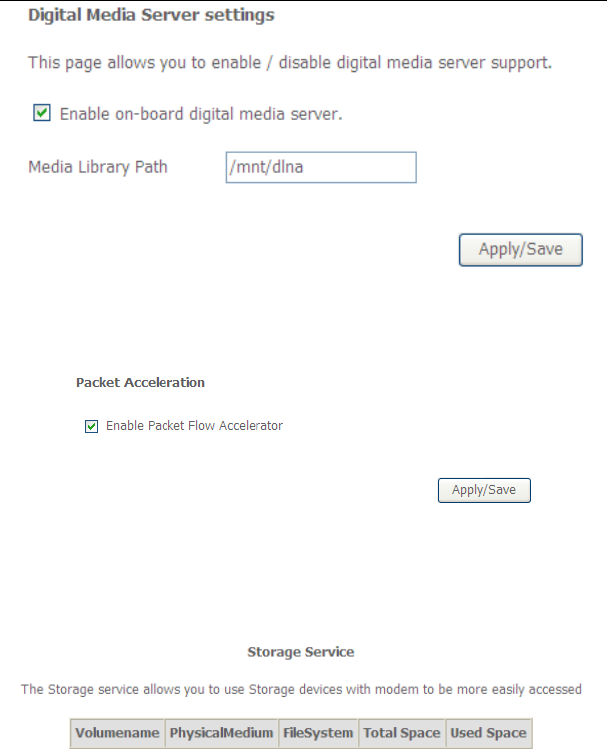
User Manual
83
5.2.16 Packet Acceleration
Choose Advanced Setup > Packet Acceleration and the following page appears.
In this page, you can enable packet flow accelerator.
5.2.17 Storage Service
Storage Device Info
Choose Advanced Setup > Storage Service > Storage Device Info and the
following page appears.
This page is used to display the information of the storage device that connects to
the DSL router.
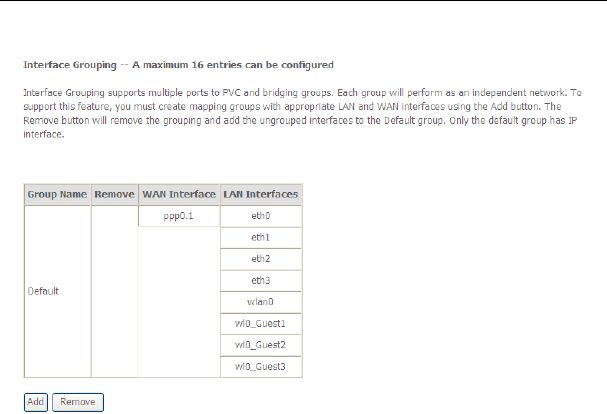
User Manual
84
5.2.18 Interface Grouping
Choose Advanced Setup > Interface Grouping and the following page appears.
Interface grouping supports multiple ports to PVC and bridging groups. Each group
will perform as an independent network. To support this feature, you must create
mapping groups with the appropriate LAN and WAN interfaces using the Add
button. The Remove button will remove the grouping and add the ungrouped
interfaces to the default group. Only the default group has IP interface.
Click the Add button to display the following page.
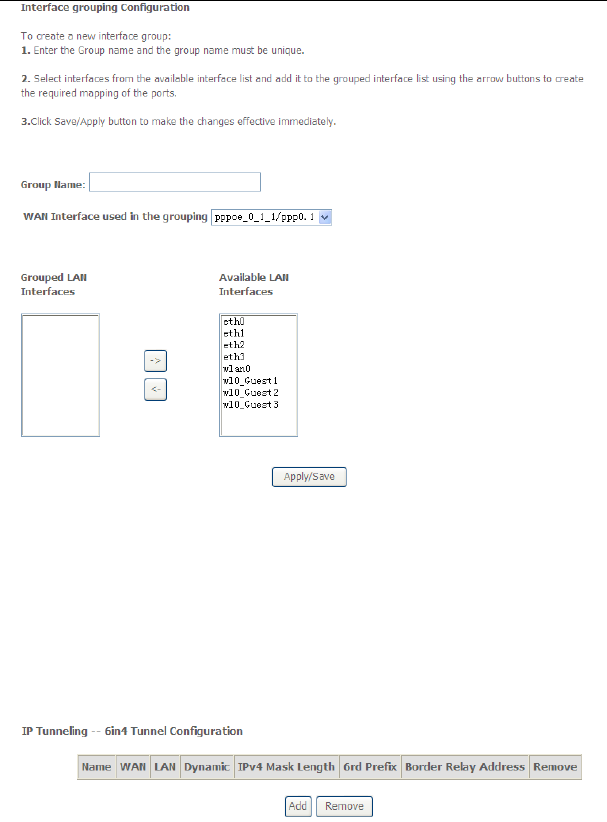
User Manual
85
In this page, please follow the on-screen configuration steps to configure the
parameters of the interface grouping.
After finishing setting, click Apply/Save to save and apply the settings.
5.2.19 IP Tunnel
5.2.19.1 IPv6 in IPv4
Choose Advanced Setup > IP Tunnel > IPv6inIPv4 and the following page
appears. The default value is IPv6 in IPv4 information.
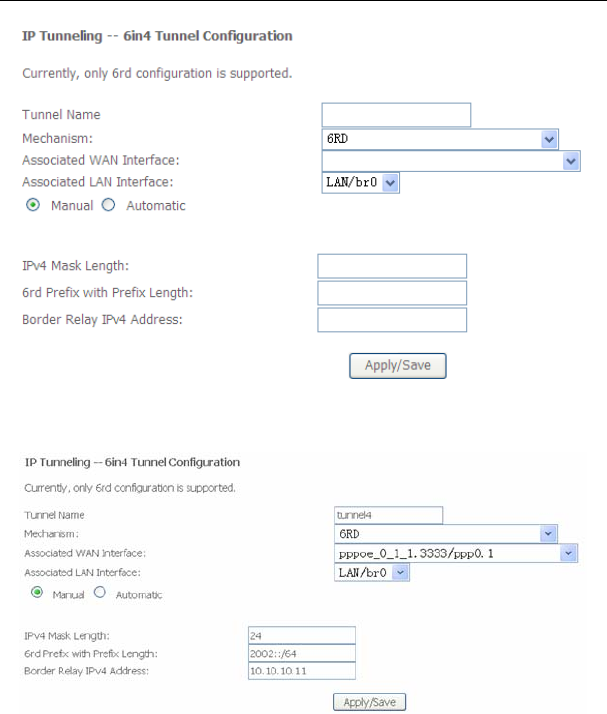
User Manual
86
Click Add and the following page appears. In this page, you can add a new tunnel.
IPv4 Mask Length: The value is 0 ~ 32.
6rd Prefix with Prefix Length: prefix/length, such as: 2002::/64.
After proper settings, click Apply/Save and the following page appears.
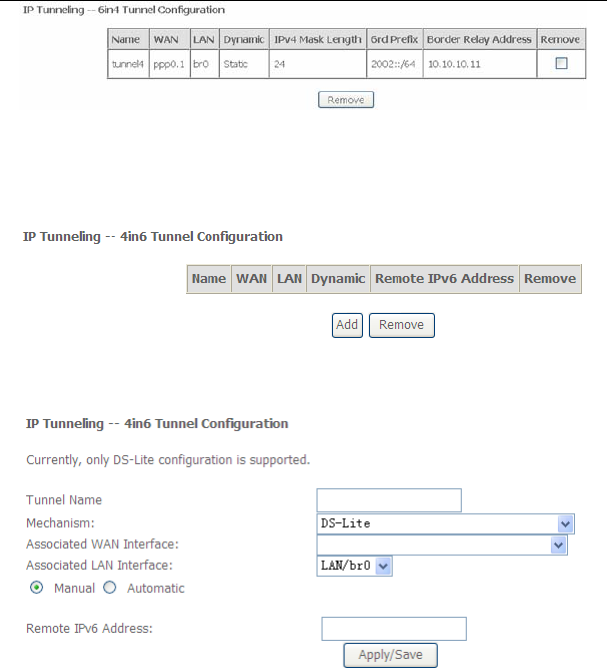
User Manual
87
5.2.19.2 IPv4 in IPv6
Choose Advanced Setup > IP Tunnel > IPv4inIPv6 and the following page
appears.
Click Add and the following page appears. In this page, you can add a new tunnel
of IPv4 in IPv6.
5.2.20 IPSec
Choose Advanced Setup > IPSec and the following page appears.

User Manual
88
In this page, you can add or remove the IPSec tunnel connections.
Click the Add button to display the following page.
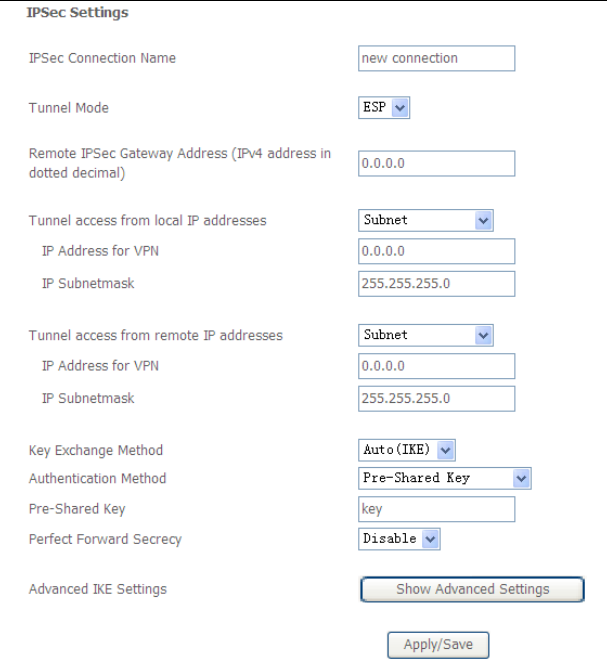
User Manual
89
In this page, set the parameters such as the IPSec connection name, tunnel mode,
and remote IPSec gateway address.
If you need to configure the advanced settings of this IPSec tunnel connection,
please click the Show Advanced Settings button to display the other parameters.
After finishing setting, click Apply/Save to save and apply the settings.

User Manual
90
5.2.21 Certificate
Local
Choose Advanced Setup > Certificate > local and the following page appears.
In this page, you can acquire the local certificate by creating a certificate request or
importing a certificate. You may also create or remove a certificate.
Creating a New Certificate Request
Click the Create Certificate Request button to display the following page.
In this page, please set the following parameters.
Certificate name: Set the certificate name.
Common Name: The common name is the "fully qualified domain name,"
(or FQDN) used for DNS lookups of your server (for example,
www.mydomain.com). Browsers use this information to identify your Web
site. Some browsers will refuse to establish a secure connection with your
site if the server name does not match the common name in the certificate.
Please do not include the protocol symbol "http://" or any port numbers or
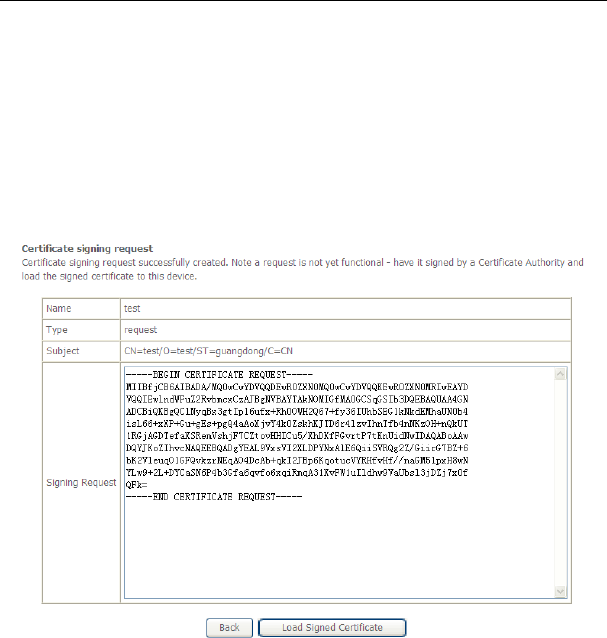
User Manual
91
pathnames in the common name. Do not use wildcard characters such as *
or ?, and do not use an IP address.
Organization Name: The name of the organization to which the entity
belongs (such as the name of a company).
State/Province Name: This is the name of the state or province where your
organization's head office is located. Please enter the full name of the state
or province.
Country/Region Name: This is the two-letter ISO abbreviation for your
country (for example, GB for the United Kingdom).
After finishing setting, click the Apply button to apply the settings.
The certificate request needs to be submitted to a certificate authority, which will
sign the request. Then the signed certificate needs to be loaded to the DSL router.
Click Load Signed Certificate in this page, and the following page appears.
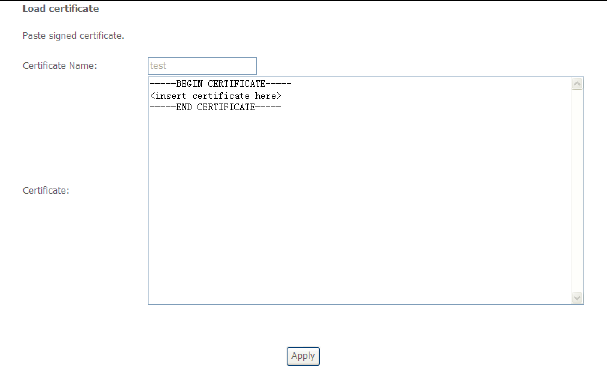
User Manual
92
In this page, paste the signed certificate, and then click the Apply button. A new
certificate is created.
Importing an Existing Local Certificate
To import an existing certificate, click the Import Certificate button to display the
following page.

User Manual
93
In this page, paste the certificate and the private key. Finally, click the Apply button
to import the certificate.
Trusted CA
Choose Advanced Setup > Certificate > Trusted CA and the following page
appears.
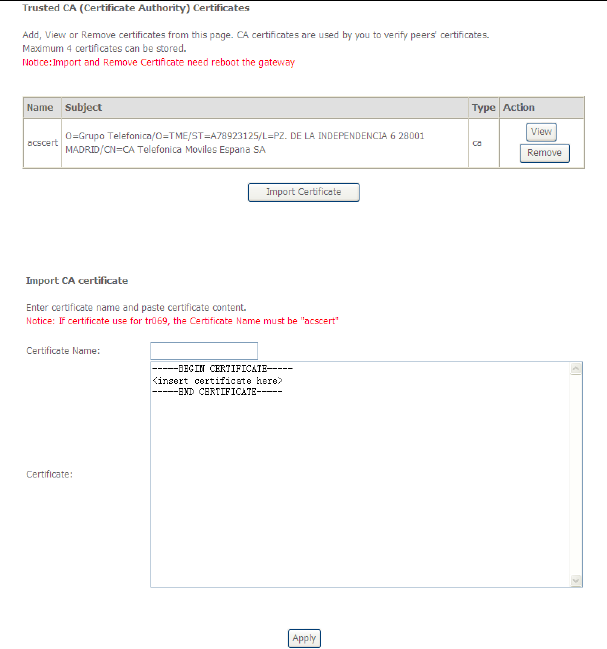
User Manual
94
In this page, you may import or remove a CA certificate.
Click the Import Certificate button to display the following page.
In this page, enter the certificate name and paste the certificate content. Finally,
click the Apply button to import the certificate.
5.2.22 Power Management
Choose Advanced Setup > Power Management and the following page appears.
This page allows control of Hardware modules to evaluate power consumption.
Use the control buttons to select the desired option.

User Manual
95
After proper configurations, click Apply to take the configurations effect.
5.2.23 Multicast
Choose Advanced Setup > Multicast and the following page appears.

User Manual
96
In this page, you can configure the multicast parameters.
After finishing setting, click Apply/Save to save and apply the settings.
5.3 Wireless
Choose Wireless and the submenus of Wireless are shown as below:

User Manual
97
5.3.1 Basic Settings
Choose Wireless > Basic to display the following page. In this page, the figure in
the right area is 2-dimensional code. It includes the wireless SSID and password.
You can obtain the wireless SSID and password through scanning this figure.

User Manual
98
This page allows you to configure the basic features of the wireless LAN interface.
Enable Wireless: Enable or disable the wireless function.
Hide Access Point: if you want to hide any access point for your router,
select this option, and then a station cannot obtain the SSID through the
passive scanning.
Clients Isolation: When many clients connect to the same access point,
they can access each other. If you want to disable the access between the
clients that connect to the same access point, you can select this option.
Disable WMM Advertise: After enabling this option, the transmission
performance multimedia of the voice and video data can be improved.
Enable Wireless Multicast Forwarding (WMF): After enabling this option,
the transmission quality of video service such as IPTV can be improved.
SSID: For the security reason, you should change the default SSID to a
unique name.
BSSID: Display the MAC address of the wireless interface.
Country: The name of the country with which your gateway is configured.
This parameter further specifies your wireless connection. For example, The
channel will adjust according to nations to adapt to each nation's frequency
provision.
Max Clients: Specify the maximum wireless client stations to be enabled to
link with AP. Once the clients exceed the max vlaue, all other clients are
refused. The value of maximum clients is 16.
Wireless - Guest/Virtual Access Points: If you want to make Guest/Virtual
network function be available, you have to check those boxes in the table
below. In the current software version, three virtual access points can be
configured.
After finishing setting, click Apply/Save to save the basic wireless settings and
make the settings take effect.
5.3.2 Security
Choose Wireless > Security to display the following page.
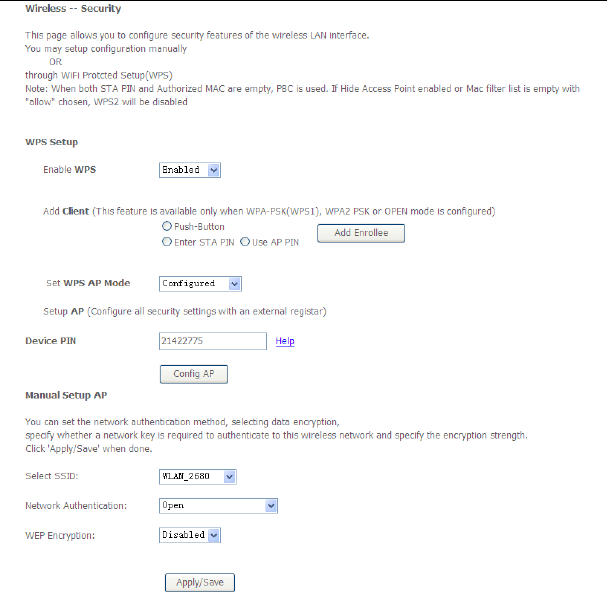
User Manual
99
This page allows you to configure the security features of the wireless LAN
interface. In this page, you can configure the network security settings by the Wi-Fi
Protected Setup (WPS) method or setting the network authentication mode.
WPS Setup

User Manual
100
There are 2 primary methods used in the Wi-Fi Protected Setup:
PIN entry, a mandatory method of setup for all WPS certified devices.
– Enter STA PIN: If you select it, you need to enter the station PIN from
client.
– Use AP PIN: The PIN is generated by AP.
Push button configuration (PBC), an actual push button on the hardware or
through a simulated push button in the software. (This is an optional method
on wireless client).
If you are using the PIN method, you will need a Registrar (access point/wireless
router) to initiate the registration between a new device and an active access
point/wireless router. (Note: The PBC method may also need a Registrar when
used in a special case where the PIN is all zeros)
In order to use the push-button for WPS authentication, you must ensure that the
network card support the function. if it supports, you need not to do any
configuration. You can press the WPS button directly to enable the WPS function.
Manual Setup AP
This page provides 9 types of network authentication modes, including Open,
Shared, 802.1X, WPA, WPA-PSK, WPA2, WPA2-PSK, Mixed WPA2/WPA, and
Mixed WPA2/WPA-PSK.
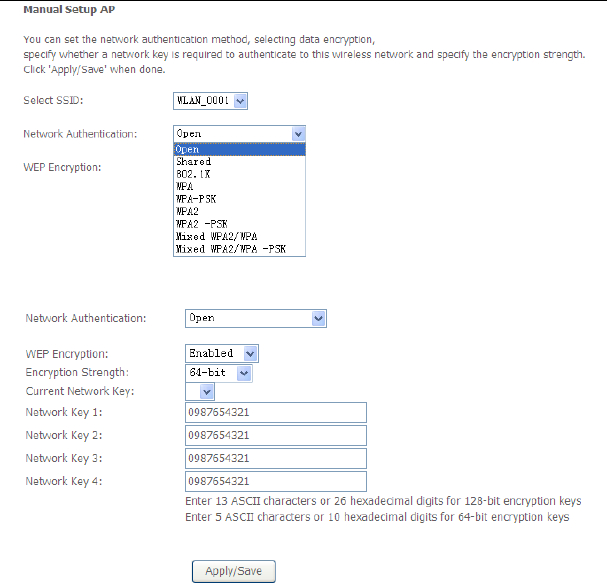
User Manual
101
- Open Mode
Select SSID: Select a SSID for configuring the security settings.
Network Authentication: Select the Open mode.
WEP Encryption: Enable or disable WEP encryption. After enabling this
function, you can set the encryption strength, current network key, and
network keys.
Encryption Strength: You can set 64-bit or 128-bit key.
Current Network Key: The current key that you use.
Network Key1/2/3/4: Set the network key. If it is 128-bit key, you need to
enter 13 ASCII characters or 26 hexadecimal digits. For the 64-bit key, you
need to enter 5 ASCII characters or 10 hexadecimal digits.
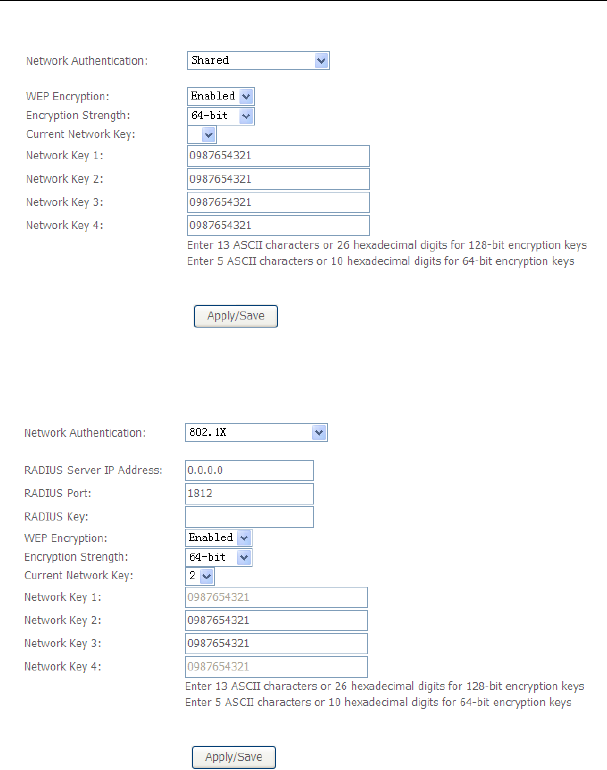
User Manual
102
- Shared Mode
The parameters’ description of shared mode, please refer to the Open Mode.
- 802.1x
Select SSID: Select a SSID for configuring the security settings.
Network Authentication: Select the 802.1X in the drop-down list.
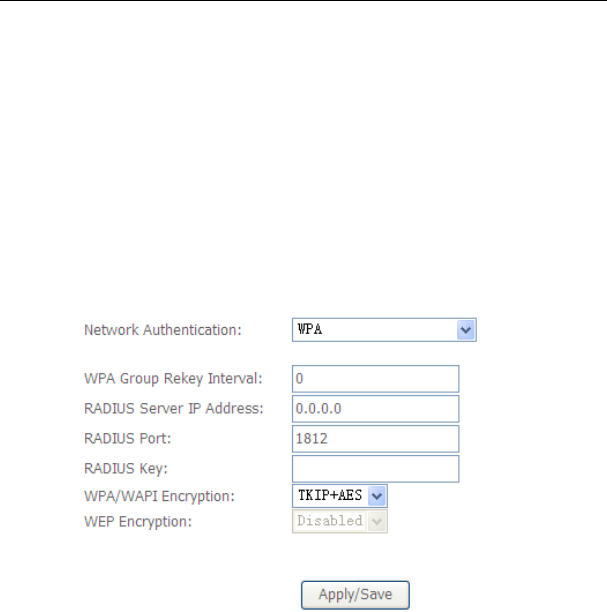
User Manual
103
RADIUS Server IP Address: Enter the IP address of the RADIUS server.
RADIUS server is used to authenticate the hosts on the wireless network.
RADIUS Port: The port number that the RADIUS server uses. The default
port number is 1812. You may change it according to the server setting.
RADIUS Key: Set the RADIUS key for accessing the RADIUS server.
WEP Encryption: You can only select Enabled.
Encryption Strength: You can set 64-bit or 128-bit key.
Current Network Key: The current key that you use.
Network Key1/2/3/4: Set the network key. If it is 128-bit key, you need to
enter 13 ASCII characters or 26 hexadecimal digits. For the 64-bit key, you
need to enter 5 ASCII characters or 10 hexadecimal digits.
- WPA Mode
Select SSID: Select a SSID for configuring the security settings.
Network Authentication: Select the WPA-PSK mode.
WPA Group Rekey Interval: Setting the interval for renewing key.
RADIUS Server IP Address: Enter the IP address of the RADIUS server.
RADIUS server is used to authenticate the hosts on the wireless network.
RADIUS Port: The port number that the RADIUS server uses. The default
port number is 1812. You may change it according to the server setting.
RADIUS Key: Set the RADIUS key for accessing the RADIUS server.
WPA/WAPI Encryption: You may select AES, or TKIP+AES.

User Manual
104
- WPA-PSK Mode
Select SSID: Select a SSID for configuring the security settings.
Network Authentication: Select the WPA-PSK mode.
WPA/WAPI passphrase: The key for WPA encryption. Click the Click here
to display button to display the current key. The default key is 87654321.
WPA Group Rekey Interval: Setting the interval for renewing key.
WPA/WAPI Encryption: You may select AES, or TKIP+AES.
- WPA2 Mode
Select SSID: Select a SSID for configuring the security settings.
Network Authentication: Select the WPA2 mode.
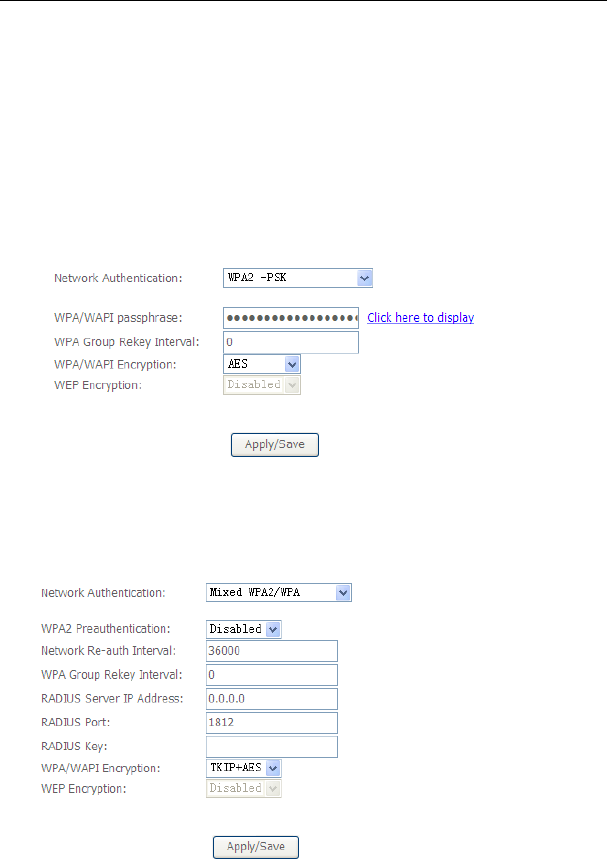
User Manual
105
WPA2 Preauthentication: Enable or disable pre-authentication.
Network Re-auth Interval: Set the network re-auth interval.
WPA Group Rekey Interval: Setting the interval for renewing key.
RADIUS Server IP Address: Enter the IP address of the RADIUS server.
RADIUS server is used to authenticate the hosts on the wireless network.
RADIUS Port: The port number that the RADIUS server uses. The default
port number is 1812. You may change it according to the server setting.
RADIUS Key: Set the RADIUS key for accessing the RADIUS server.
WPA/WAPI Encryption: You may select AES, or TKIP+AES.
- WPA2-PSK
The parameters’ description of WPA2-PSK mode, please refer to the WPA-PSK
mode.
- Mixed WPA2/WPA

User Manual
106
The parameters’ description of Mixed WPA2/WPA mode, please refer to the WPA2
mode.
- Mixed WPA2/WPA-PSK
The parameters’ description of Mixed WPA2/WPA-PSK mode, please refer to the
WPA-PSK mode.
5.3.3 MAC Filter
Choose Wireless > MAC Filter to display the following page.

User Manual
107
This page is used to allow or reject the wireless clients to access the wireless
network of the wireless router.
In this page, you can add or remove the MAC filters.
The MAC restrict modes include Disabled, Allow, and Deny.
Disabled: Disable the wireless MAC address filtering function.
Allow: Allow the wireless clients with the MAC addresses in the MAC
Address list to access the wireless network of the wireless router.
Deny: Reject the wireless clients with the MAC addresses in the MAC
Address list to access the wireless network of the wireless router.
Click the Add button to display the following page.
In this page, enter the MAC address of the wireless client, and then click the
Apply/Save button to add the MAC address to the MAC address list.
5.3.4 Wireless Bridge
Choose Wireless > Wireless Bridge to display the following page.
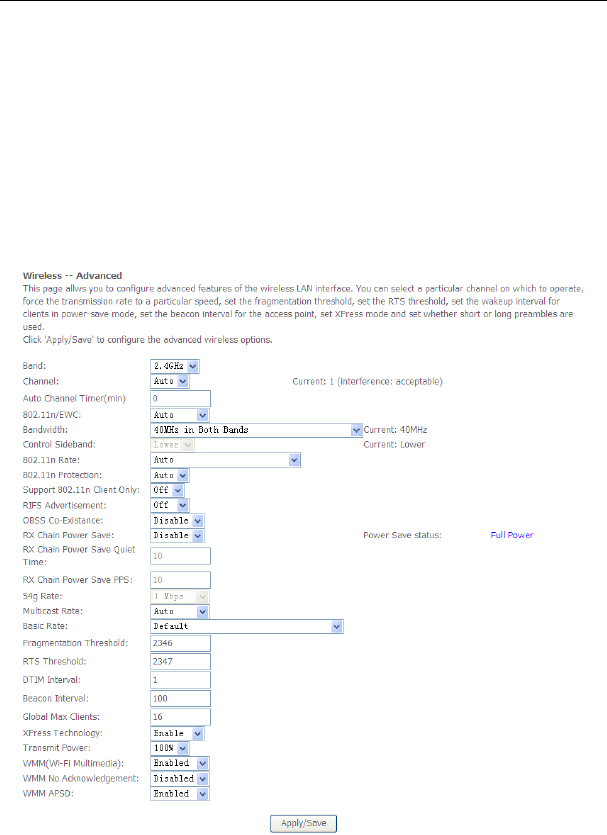
User Manual
108
This page allows you to configure the wireless bridge features of the wireless LAN
interface.
AP mode: you may select Access Point or Wireless Bridge.
Bridge Restrict: Enable or disable the bridge restrict function.
Remote Bridges MAC Address: Enter the remote bridge MAC address.
After finishing setting, click the Apply/Save button to save and apply the settings.
5.3.5 Advanced Settings
Choose Wireless > Advanced to display the following page. This page allows you
to configure the advanced features of the wireless LAN interface. Usually, you do
not need to change the settings in this page.
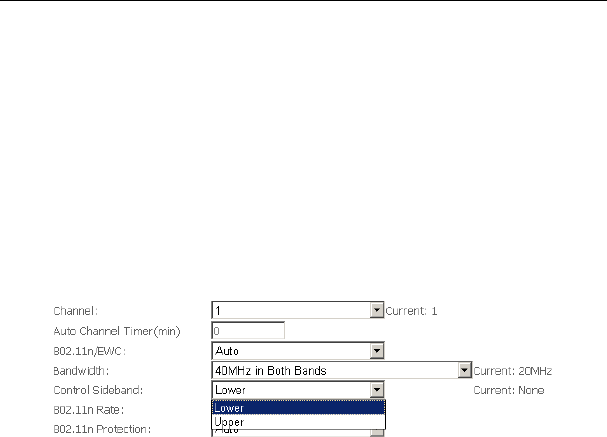
User Manual
109
Band: You can select 2.4GHz or 5GHz.
Channel: Fill in the appropriate channel to correspond with your network
settings. All devices in your wireless network must use the same channel in
order to work correctly. This router supports auto channeling functionality.
Auto Channel Timer(min): Specifies the timer of auto channelling.
802.11n/EWC: Select disable 802.11n or Auto.
Bandwidth: Select the bandwidth for the network. You can select 20MHz in
Both Bands, 20MHz in 2.4G Band and 40MHz in 5G Band, or 40MHz in
Both Bands.
Control Sideband: If you select 20MHz in Both Bands or 20MHz in 2.4G
Band and 40MHz in 5G Band, the service of control sideband does not
work. When you select 40MHz in Both Bands as the bandwidth, the
following page appears. Then you can select Lower or Upper as the value
of sideband. As the control sideband, when you select Lower, the channel is
1~7. When you select Upper, the channel is 5~11.
802.11n Rate: Select the transmission rate for the network. The rate of data
transmission should be set depending on the speed of your wireless network.
You can select from a range of transmission speeds, or you can select Auto
to have the Router automatically use the fastest possible data rate and
enable the Auto-Fallback feature. Auto-Fallback will negotiate the best
possible connection speed between the Router and a wireless client. The
default value is Auto.
802.11n Protection: The 802.11n standards provide a protection method so
802.11b/g and 802.11n devices can co-exist in the same network without
“speaking” at the same time.
Support 802.11n Client Only: Only stations that are configured in 802.11n
mode can associate.
Multicast Rate: Select the multicast transmission rate for the network. The
rate of data transmission should be set depending on the speed of your
wireless network. You can select from a range of transmission speeds, or
you can select Auto to have the Router automatically use the fastest
possible data rate and enable the Auto-Fallback feature. Auto-Fallback will
negotiate the best possible connection speed between the Router and a
wireless client. The default value is Auto.
Basic Rate: Select the basic transmission rate ability for the AP.

User Manual
110
Fragmentation Threshold: Packets that are larger than this threshold are
fragmented into multiple packets. Try to increase the fragmentation
threshold if you encounter high packet error rates. Do not set the threshold
too low, since this can result in reduced networking performance.
RTS Threshold: This value should remain at its default setting of
2347.Should you encounter inconsistent data flow, only minor reductions are
recommended. Should you encounter inconsistent data flow, only minor
reduction of the default value, 2347, is recommended. If a network packet is
smaller than the preset RTS threshold size, the RTS/CTS mechanism will
not be enabled. The Router sends Request to Send (RTS) frames to a
particular receiving station and negotiates the sending of a data frame. After
receiving an RTS, the wireless station responds with a Clear to Send (CTS)
frame to acknowledge the right to begin transmission. The RTS Threshold
value should remain at its default value of 2347.
DTIM Interval: (Delivery Traffic Indication Message) Enter a value between
1 and 255 for the Delivery Traffic Indication Message (DTIM.) A DTIM is a
countdown informing clients of the next window for listening to broadcast
and multicast messages.
Beacon Interval: A beacon is a packet of information that is sent from a
connected device to all other devices where it announces its availability and
readiness. A beacon interval is a period of time (sent with the beacon) before
sending the beacon again. The beacon interval may be adjusted in
milliseconds (ms). Default (100) is recommended.
XPress Technology: Select Enable or Disable. This is a special
accelerating technology for IEEE802.11g. The defaule is Disabled.
Transmit Power: Adjust the transmission range here. This tool can be
helpful for security purposes if you wish to limit the transmission range.
WMM (Wi-Fi Multimedia): Select whether WMM is enable or disabled.
Before you disable WMM, you should understand that all QoS queues or
traffic classes relate to wireless do not take effects.
WMM No Acknowledgement: Select whether ACK in WMM packet. By
default, the 'Ack Policy' for each access category is set to Disable, meaning
that an acknowledge packet is returned for every packet received. This
provides a more reliable transmission but increases traffic load, which
decreases performance. To disable the acknowledgement can be useful for
Voice, for example, where speed of transmission is important and packet
loss is tolerable to a certain degree.
WMM APSD: APSD is short for automatic power save delivery, Selecting
enable will make it has very low power consumption. WMM Power Save is
an improvement to the 802.11e amendment adding advanced power
management functionality to WMM.
Click Apply/Save to configure the advanced wireless options and make the
changes take effect.
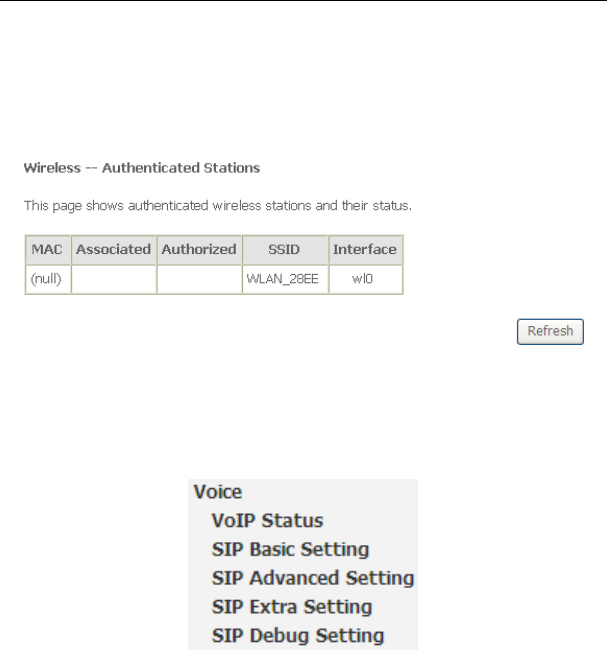
User Manual
111
Note:
The advanced wireless setting is only for the advanced user. For the common
user, do not change any settings in this page.
5.3.6 Station Info
Choose Wireless > Station Info to display the following page.
This page shows the authenticated wireless stations and their status.
5.4 Voice
Choose Voice and the submenus of Voice are shown as below.
5.4.1 VoIP Status
Choose Voice > VoIP Status and the Voice Status page appears. In the
Registration Status field, Up means registered successfully, Down means
unregistered, Disable means account is not enabled.

User Manual
112
5.4.2 SIP Basic Setting
Choose Voice > SIP Basic Setting, and the following page appears.

User Manual
113
Figure 7 SIP Basic Setting – 1
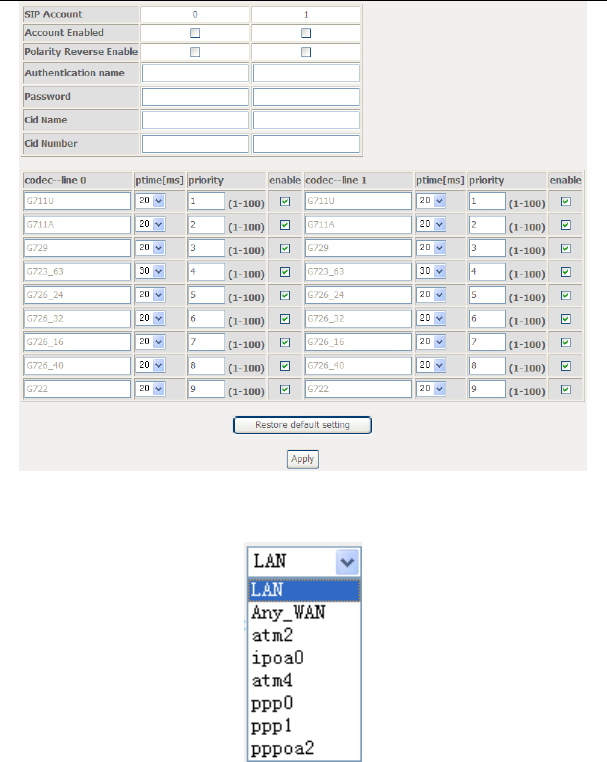
User Manual
114
Figure 8 SIP Basic Setting - 2
Bound Interface Name: you can select the bound interface name from the
drop-down list.
SIP Local Port: Set the SIP local port of the gateway, the default value is
5060. SIP local port is the SIP UA (user agent) port.
SIP domain name: Enter the SIP domain name that you want to set.
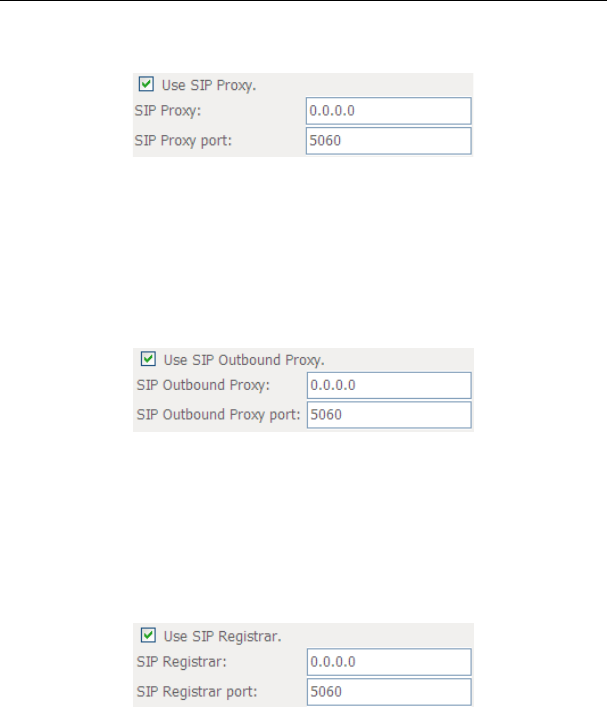
User Manual
115
Use SIP Proxy: Select the checkbox of Use SIP Proxy, if your DSL router
uses a SIP proxy. SIP proxy allows other parties to call DSL router through it.
When it is selected, the following fields appear.
– SIP Proxy: The IP address of the proxy.
– SIP Proxy port: The port that this proxy is listening on. By
default, the port value is 5060.
Use SIP Outbound Proxy: Some network service providers require the use
of an outbound proxy. This is an additional proxy, through which all outgoing
calls are directed. In some cases, the outbound proxy is placed alongside the
firewall and it is the only way to let SIP traffic pass from the internal network
to the Internet. When it is selected, the following fields appear.
– SIP Outbound Proxy: The IP address of the outbound
proxy.
– SIP Outbound Proxy port: The port that the outbound
proxy is listening on. By default, the port value is 5060.
Use SIP Registrar: Select the checkbox of Use SIP Registrar to register
with the proxy. You can register your user ID on the SIP registrar. SIP
registrar works with SIP proxy, allowing other parties to call DSL router
through it. When it is selected, the following fields appear.
– SIP Registrar: The IP address of the SIP registrar.
– SIP Registrar port: The port that SIP registrar is listening
on. By default, the port value is 5060.
Account Enabled: If it is unselected, the corresponding account is disabled.
You can not use it to initiate or accept any call.
Polarity Reverse Enable: Enable or disable this function.

User Manual
116
Authentication name: Set the user name of authentication.
Password: Set the password of authentication.
Cid Name: User name. It is the Display Name.
Cid Number: Set the caller number. It must be a number of 0~9.
ptime: You can use it to set the packetization time (PT). The PT is the length
of the digital voice segment that each packet holds. The default is 20
millisecond packets. If selecting 10 millisecond, packets improve the voice
quality. Because of the packet loss, less information is lost, but more loads
on the network traffic.
Priority: The priority of codec is declined from up to down. Codecs define the
method of relaying voice data. Different codecs have different characteristics,
such as data compression and voice quality. For Example, G723 is a codec
that uses compression, therefore, it is good for use where the bandwidth is
limited but its voice quality is not good as other codecs, such as the G711. If
you specify none of the codecs, using the default value showed in the above
figure, the DSL router chooses the codec automatically.
After setting, click Apply to take the settings in to effect.
5.4.3 SIP Advanced Setting
Choose Voice > SIP Advanced Setting, and the following page appears.
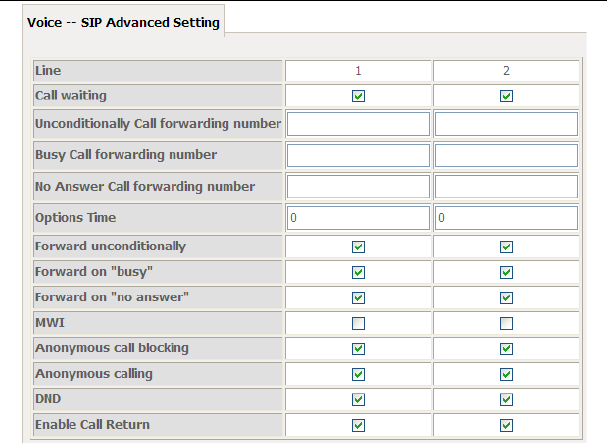
User Manual
117
Figure 9 SIP Advanced Setting - 1
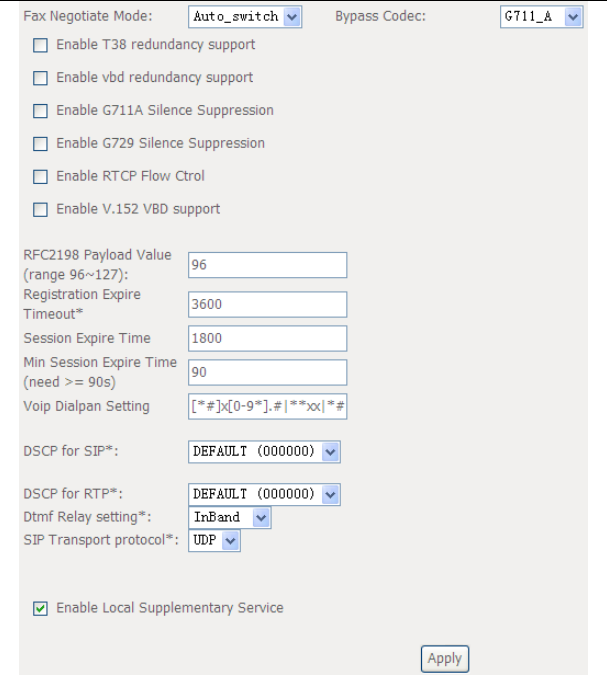
User Manual
118
Figure 10 SIP Advanced Setting - 2
Line: It displays the line you want to configure.
Call waiting:
If call waiting is enabled on a line, you can hear the call waiting tone during a call,
press FLASH on the phone to answer the second call. The first call is automatically
placed on hold. To switch between calls, press FLASH again.
Select Call waiting to enable this feature.

User Manual
119
Call forward feature settings (Busy or All) take priority over the call waiting feature.
Call waiting feature is ignored on new incoming calls if there is already a call on
hold or in conference.
Unconditionally Call forwarding number: Enter the number that you want
to set. It is the feature that forwards all incoming calls to an appointed
number unconditionally.
Busy Call forwarding number: Enter the number that you want to set. It is a
feature that forwards all incoming calls to an appointed number when the line
is busy.
No Answer Call forwarding number: Enter the number that you want to set.
It is a feature that forwards all incoming calls to an appointed number when
the call is not answered.
Options Time: Set the time interval for sending the Options message.
Forward unconditionally: Select the check box to enable this function.
Forward on "busy": Select the check box to enable this function.
Forward on "no answer": Select the check box to enable this function.
MWI: When selecting message waiting indicator (MWI), the DSL router
sends a SIP SUBSCRIBE message to the proxy, asking for a notification
when its voicemail status changes. When its status does change, the proxy
send a NOTIFY message to the gateway, causing a MWI tone streamed to
user’s receiver.
Anonymous call blocking
It is a feature that can block the anonymous call.
Select the checkbox of Anonymous call blocking to enable this feature. You can
also dial *77 to enable this feature. Dial *87 to disable this feature.
Anonymous calling
It is a feature that allows using anonymous name as a call number when calling
out.
Select the checkbox of Anonymous calling to enable this feature. You can also
dial *68 to enable this feature. Dial *82 to disable this feature.
DND
It is a feature to reject all incoming calls.
Select the checkbox of DND to enable this feature. You can also Dial *78 to enable
the feature.
Enable Call Return: Select the check box to enable this function.
Fax Negotiate Mode: You can select it from the drop-down list.

User Manual
120
Bypass Codec: You can select it from the drop-down list.
Enable T38 redundancy support: Select the check box to enable this
function.
Enable vbd redundancy support: Select the check box to enable this
function.
RFC2198 Payload Value (range 96~127): Enter the RFC2198 payload
value that the valid range is 96 ~ 127.
Registration Expire Timeout*: Enter the registration expire timeout.
Session Expire Time: The interval of dialog refreshing time.
Min Session Expire Time: The minimum interval of dialog refreshing time.
VoIP DialPlan Setting: Set the VoIP dial plan. If user-dialed number
matches it, the number is processed by the DSL router immediately.
DSCP for SIP: Set the DSCP for SIP. You can select it from the drop-down
list.
DSCP for RTP: Set the DSCP for RTP. You can select it from the drop-down
list.
Dtmf Relay Setting: Set DTMF transmit method, which can be following
values:
– SIP Info: Use SIP INFO message to transmit DTMF digits.
– RFC2833: Use RTP packet to encapsulate DTMF events,
as specified in RFC 2833.
– InBand: DTMF events are mixed with user voice in RTP
packet.

User Manual
121
SIP Transport Protocol: Select the transport protocol to use for SIP
signaling. Note that the SIP proxy and registrar need to support the protocol
you select.
Enable Local Supplementary Service: Select the checkbox to enable the
supplementary service settings by the telephone set. If you deselect the
checkbox, the supplementary service can not be set by the telephone set.
After setting, click Apply to take the settings in to effect.
5.4.4 SIP Extra Setting
Choose Voice > SIP Extra Setting, and the following page appears.
Dial tone time: Dial tone duration.
Busy tone time: Busy tone duration.
Inter digit time: The valid range is 1 ~ 5.
Offhook warning tone time: Offhook warning tone duration.
Ringback tone time: Ringback tone duration.
After setting, click Apply to take the settings in to effect.
5.4.5 SIP Debug Setting
Choose Voice > SIP Debug Setting, and the following page appears.
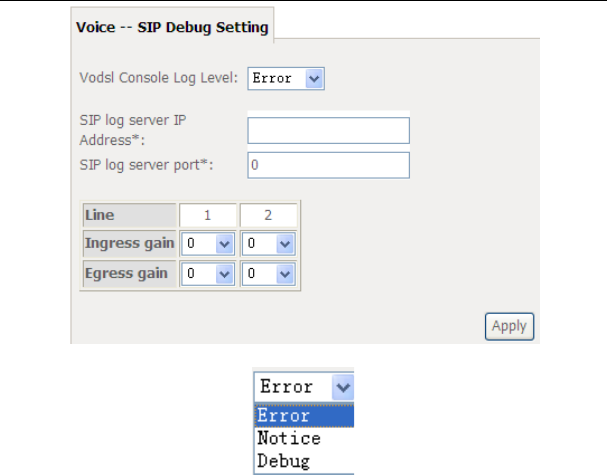
User Manual
122
Vodsl Console Log Level: Select it from the drop-down list.
SIP Log Server Settings: Set SIP log server IP address and port, then the
log message of the VoIP is sent to the device which IP address you set to. If
you want use this function, both of the IP address and port must be set
correctly.
Gain Settings: Gain is a measure of the ability of a circuit (often an amplifier)
to increase the power or amplitude of a signal. You can increase or decrease
ingress gain and egress gain. The range of the value is from -14 to 6.
5.4.6 VoIP Functionality
This section describes how to use the VoIP function of the DSL router in more
detail. Some features involve 2 or 3 parties. In that case, note that all 3 parties have
to be successfully registered.
5.4.6.1 Registering
Before using any VoIP functions, the DSL router has to register itself to a registrar.
The DSL router also has to be configured with a proxy, which relays VoIP signaling

User Manual
123
to the next hop. In fact, many implementations integrate these two into one server,
so in many case registrar and proxy refer to the same IP.
Step 1 Select the right interface to use for registering, depending on where
proxy/registrar resides. If use WAN link, ensure that it is already up.
Step 2 Select the checkbox of Use SIP Registrar, and fill in the IP address and
port with the right value.
Step 3 Fill the extension information: Authentication name, Password, Cid
Name and Cid Number.
Step 4 Click Apply to take the settings into effect.
Step 5 TEL indicator of VoIP service should be on, indicating that SIP client is
successfully registered.
5.4.6.2 Placing a Call
This section describes how to place a basic VoIP call.
(1) Pick up the receiver on the phone.
(2) Hear the dial-tone. Dial the extension of remote party.
(3) To end the dialing, wait for digit timeout, or just press # immediately.
(4) After the remote party answers the call, you are in voice connection.
5.4.6.3 Anonymous call
Anonymous call does not send the caller ID to the remote party. This is useful if you
do not want others know whom you are.
(1) Enable Anonymous calling in the Voice--SIP Advanced Setting web page.
(2) Pick up the receiver on the phone.
(3) Dial *68 to enable anonymous call.
(4) Hook on the receiver, and dial another extension as you like. Now your caller ID
information is blocked.
5.4.6.4 Do Not Disturb (DND)
If DND is enabled, all incoming calls are rejected. DND is useful if you do not want
others to disturb you.
(1) Enable DND in the Voice--SIP Advanced Setting web page.
(2) Pick up the receiver on the phone.
(3) Dial *78 to enable DND.
(4) Hook on the phone. Now your phone rejects all incoming calls.
(5) Hook off again to disable the DND.

User Manual
124
5.4.6.5 Call Return
For incoming calls, the DSL router remembers the number of calling party.
(1) Enable Call Return in the Voice--SIP Advanced Setting web page.
(2) Press *69 to return a call.
(3) Now you can make the call as if you have dialed the whole number.
5.4.6.6 Call Hold
Call hold enable you to put a call to a pending state, and pick it up in future.
(1) Assuming you are in a voice connection, you can press FLASH to hold current
call.
(2) Now you can call another party, or press FLASH again to return to first call.
5.4.6.7 Call Waiting
Call waiting allows third party to call in when you are in a voice connection.
(1) Enable Call waiting in the Voice--SIP Advanced Setting web page.
(2) Pick up the phone attached to the DSL router.
(3) Assuming you are in a voice connection. When another call comes in, the DSL
router streams a call waiting tone to your phone, indicating another call is
available.
(4) Press FLASH to switch to this call and the initial call put to hold automatically.
(5) Press FLASH multi-times to switch between these two calls back and forth.
5.4.6.8 Blind Transfer
Blind transfer transfers the current call to a third party blindly, regardless of whether
the transfer is successfully or not.
(1) Assume you have already been in a voice connection.
(2) Press FLASH to hold the first party.
(3) Dial #90 + third party number.
(4) Before the third party answering the call, hook on your phone.
(5) Now the first party takes over the call and he is in connection with the third
party.
5.4.6.9 Consultative Transfer
Consultative transfer lets the third party answer the transferred call, and then hook
on the transferring party. It’ more gentle than blind transfer.
(1) Assume you have already been in a voice connection with a first party.

User Manual
125
(2) Press FLASH to hold the first party.
(3) Dial #91 + third party number.
(4) After the third party answering the call, hook on your phone.
(5) Now the first party takes over the call and he is in connection with the third
party.
5.4.6.10 Call Forwarding No Answer
If this feature enabled, incoming calls are forwarded to third party when you does
answer them. It involves in two steps: setting the forwarding number and enable
the feature.
(1) Enable Forward on "no answer" in the Voice--SIP Advanced Setting web
page.
(2) When our phone does not answer the incoming call, the call is forwarded.
5.4.6.11 Call Forwarding Busy
If this feature enabled, incoming calls will be forwarded to third party when you
busy. It involves two steps: setting the forwarding number and enable the feature.
(1) Set Busy Call forwarding number and enable Forward on "busy" in the
Voice--SIP Advanced Setting web page.
(2) When our phone is busy, this call can be forwarded.
5.4.6.12 Call Forwarding All
If this feature enabled, incoming calls are forwarded to third party without any
reason. It involves in two steps: setting the forwarding number and enable the
feature.
(1) Set Unconditionally Call forwarding number and Forward
unconditionally in the Voice--SIP Advanced Setting web page.
(2) All incoming calls are forwarded to the third party.
5.4.6.13 Three-Way Conference
Three-way conference enables you to invite a third party to a call, and every person
in the conference is able to hear others’ voice.
(1) Assume you are in connection with a first party.
(2) Press FALSH to put the first party on-hold.
(3) Dial a third party.
(4) After the third party answers the call, press FLASH again to invite the first party.

User Manual
126
(5) Now all three parties are in a three-way conference.
5.4.6.14 T38 Faxing
To make T38 faxing, enable T38 support on the Web. After that, connect a fax
machine to a FXS port of the DSL router. Now you can use it as a normal phone,
and it is able to send or receive fax to or from other fax machines on the VoIP
network.
In the initial setup, faxing behaves like a normal call. After the DSL router detects
the fax tone, it switch to T38 mode, and use it as the transmit approach.
5.4.6.15 Pass-Through Faxing
If T38 support is disabled, faxing uses normal voice codec as its coding approach.
Therefore, this mode more like normal phone calls.
5.5 Diagnostics
5.5.1 Diagnostics
Click Diagnostics > Diagnostics, and the following page appears.
This page is used to test the connection to your local network, the connection to
your DSL service provider, and the connection to your Internet service provider.
You may diagnose the connection by clicking the Test button or click the Test With
OAM F4 button. If the test continues to fail, click Help and follow the
troubleshooting procedures.
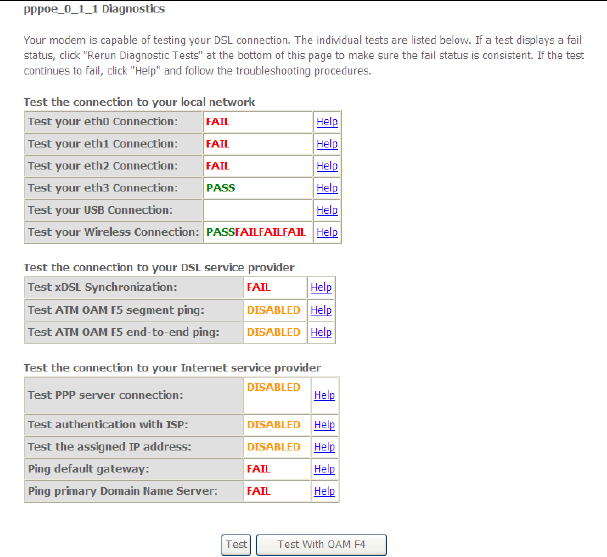
User Manual
127
5.5.2 Fault Management
Note:
The Fault Management is only available for VDSL PTM
Click Diagnostics > Fault Management, and the following page appears.
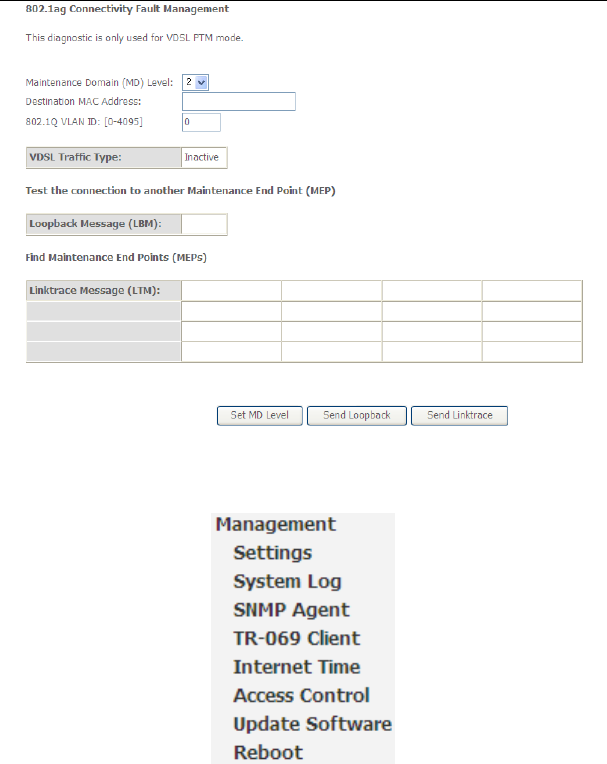
User Manual
128
5.6 Management
Choose Management and the submenus of Management are shown as below:

User Manual
129
5.6.1 Settings
Backup
Choose Management > Settings > Backup to display the following page.
In this page, click the Backup Settings button to save your router’s settings to your
local PC.
Update
Choose Management > Settings > Update, and the following page appears.
In this page, click the Browse… button to select the correct new settings file, and
then click the Update Settings button to update the router’s settings.
Restore Default
Choose Management > Settings > Restore Default to display the following page.
In this page, click the Restore default settings button, and then system returns to
the default settings.

User Manual
130
5.6.2 System Log
Choose Management > System Log to display the following page.
In this page, you are allowed to configure the system log and view the security log.
Configuring the System Log
Click the Configure System Log button to display the following page.
In this page, you can set 3 types of system log modes, including Local, Remote, and
Both.
Local: When selecting Local, the events are recorded in the local memory.
Remote: When selecting Remote, the events are sent to the specified IP
address and UDP port of the remote system log server.
Both: When selecting Both, the events are recorded in the local memory or
sent to the specified IP address and UDP port of the remote system log
server.
After finishing setting, click the Apply/Save button to save and apply the settings.
Note:
If you want to log all the events, you need to select the Debugging log level.
View System Log
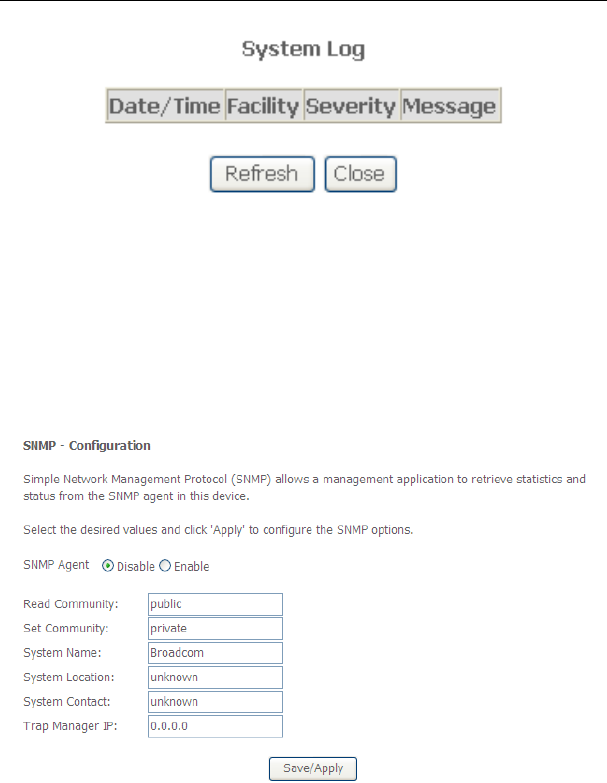
User Manual
131
Click the View System Log button to display the following page.
In this page, you can view the system log.
Click the Refresh button to refresh the system log. Click the Close button to exit.
5.6.3 SNMP Agent
Choose Management > SNMP Agent, and the following page appears.
Simple Network Management Protocol (SNMP) allows a management application to
retrieve statistics and status from the SNMP agent in this device.

User Manual
132
In this page, you may enable or disable the SNMP agent and set the parameters such
as the read community, system name and trap manager IP.
After finishing setting, click the Save/Apply button to save and apply the settings.
5.6.4 TR-69 Client
Choose Management > TR-069Client to display the following page.
WAN Management Protocol (TR-069) allows an Auto-Configuration Server (ACS) to
perform auto-configuration, provision, collection, and diagnostics to this device.
In this page, you may configure the parameters such as the ACS URL, ACS
password, and connection request user name.
After finishing setting, click the Apply/Save button to save and apply the settings.
5.6.5 Internet Time
Choose Management > Internet Time to display the following page.
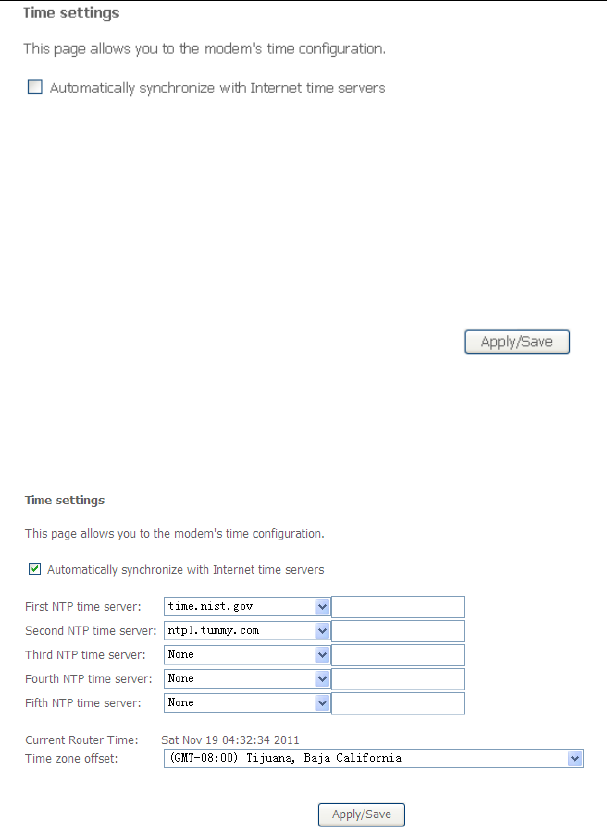
User Manual
133
In this page, you may configure the router to synchronize its time with the Internet
time servers.
After enabling Automatically synchronize with Internet time servers, the following
page appears.

User Manual
134
In this page, set the proper time servers, and then click the Apply/Save button to
save and apply the settings.
5.6.6 Access Control
Passwords
Choose Management > Access Control > Passwords, and the following page
appears.
In the page, you can modify the username and password of different users.
After finishing setting, click the Apply/Save button to save and apply the settings.
Services
Choose Management > Access Control > Services Control and the following page
appears.

User Manual
135
In this page, you can enable or disable the different types of services.
After finishing setting, click the Apply/Save button to save and apply the settings.
5.6.7 Update Software
Choose Management > Update Software, and the following page appears.
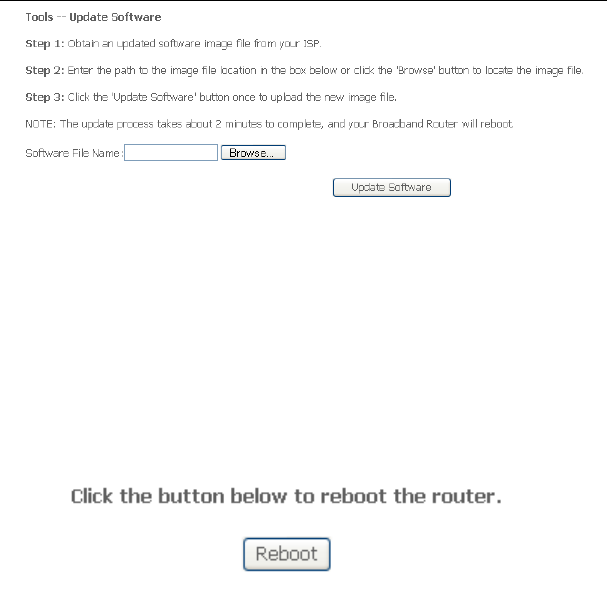
User Manual
136
If you want to upload the software, click the Browse… button to choose the new
software, and then click the Update Software button.
Note:
When software update is in progress, do not shut down the router. After software
update completes, the router automatically reboots.
Please make sure that the new software for updating is correct, and do not use other
software to update the router.
5.6.8 Reboot
Choose Management > Reboot and the following page appears.
In this page, click the Reboot button, and then the router reboots.
6 Q&A
(1) Q: Why all the indicators are off?
A: Check the following:
The connection between the power adaptor and the power socket.
The status of the power switch.
(2) Q: Why the LAN indicator is off?
A: Check the following:

User Manual
137
The connection between the ADSL router and your computer, hub, or
switch.
The running status of your PC, hub, or switch.
(3) Q: Why the DSL indicator is off?
A: Check the connection between the “DSL” port of router and the wall jack.
(4) Q: Why Internet access fails while the DSL indicator is on?
A: Check whether the VPI, VCI, user name, and password are correctly
entered.
(5) Q: Why I fail to access the web configuration page of the DSL router?
A: Choose Start > Run from the desktop, and ping 192.168.1.1 (IP address of
the DSL router). If the DSL router is not reachable, check the type of the
network cable, the connection between the DSL router and the PC, and
the TCP/IP configuration of the PC.
(6) Q: How to load the default settings after incorrect configuration?
A: To restore the factory default settings, turn on the device, and press the
reset button for about 1 second, and then release it. The default IP
address and the subnet mask of the DSL router are 192.168.1.1 and
255.255.255.0, respectively.
User/password of super user: admin/admin
User/password of common user: user/user
ANNEX A
Part 68
FCC - PART 68
This equipment complies with Part 68 of the FCC rules and the
requirements adopted by the ACTA. On the bottom case equipment is
a label that contains, among other information, a product identifier in
the format US: VW7DL02BSR630N and REN:0.19B for this
equipment.
This equipment uses the following USOC jacks: RJ-11/RG45,Power
jack ,USB Jack!

User Manual
138
A plug and jack used to connect this equipment to the premises wiring
and telephone network must comply with the applicable FCC Part 68
rules and requirements adopted by the ACTA. A compliant telephone
cord and modular plug is provided with this product. It is designed to
be connected to a compatible modular jack that is also compliant. See
installation instructions for details.
REN (RINGER EQUIVALENT NUMBERS) STATEMENT
Notice: The Ringer Equivalence Number (REN) assigned to each
terminal device provides an indication of the maximum number of
terminals allowed to be connected to a telephone interface. The
termination on an interface may consist of any combination of devices
subject only to the requirement that the sum of the Ringer Equivalence
Numbers of all the devices does not exceed 5.
If this equipment US: VW7DL02BSR630N causes harm to the
telephone network, the telephone company will notify you in advance
that temporary discontinuance of service may be required. But if
advance notice isn't practical, the telephone company will notify the
customer as soon as possible. Also, you will be advised of your right
to file a complaint with the FCC if you believe it is necessary.
The telephone company may make changes in its facilities, equipment,
operations or procedures that could affect the operation of the
equipment. If this happens the telephone company will provide
advance notice in order for you to make necessary modifications to
maintain uninterrupted service.
If trouble is experienced with this equipment US ID , for repair or
warranty information, please contact SmartRG,INC,. If the equipment
is causing harm to the telephone network, the telephone company may
request that you disconnect the equipment until the problem is resolved.
Connection to party line service is subject to state tariffs. Contact the
state public utility commission, public service commission or

User Manual
139
corporation commission for information.
If your home has specially wired alarm equipment connected to the
telephone line, ensure the installation of this [US:VW7DL02BSR630N]
does not disable your alarm equipment. If you have questions about
what will disable alarm equipment, consult your telephone company or
a qualified installer.
his product meets the applicable Industry Canada technical
specifications. / Le présent matériel est conforme aux specifications
techniques applicables d’Industrie Canada.
FCC
FCC Statement
This equipment has been tested and found to comply with the limits
for a Class B digital device, pursuant to part 15 of the FCC Rules.
These limits are designed to provide reasonable protection against
harmful interference in a residential installation. This equipment
generates, uses and can radiate radio frequency energy and, if not
installed and used in accordance with the instructions, may cause
harmful interference to radio communications. However, there is no
guarantee that interference will not occur in a particular installation.
If this equipment does cause harmful interference to radio or
television reception, which can be determined by turning the
equipment off and on, the user is encouraged to try to correct the
interference by one or more of the following measures:
—Reorient or relocate the receiving antenna.
—Increase the separation between the equipment and receiver.
—Connect the equipment into an outlet on a circuit different from
that to which the receiver is connected.
—Consult the dealer or an experienced radio/TV technician for help.

User Manual
140
FCC Radiation Exposure Statement
This device complies with FCC radiation exposure limits set forth for
an uncontrolled environment and it also complies with Part 15 of the
FCC RF Rules. This equipment must be installed and operated in
accordance with provided instructions and the antenna(s) used for
this transmitter must be installed to provide a separation distance of
at least 20 cm from all persons and must not be co-located or
operating in conjunction with any other antenna or transmitter.
This device complies with Part 15 of the FCC Rules. Operation is
subject to the following two conditions: (1) this device may not
cause harmful interference, and (2) this device must accept any
interference received, including interference that may cause
undesired operation.
Caution!
Any changes or modifications not expressly approved by the party
responsible for compliance could void the user's authority to operate
the equipment.
IC-CS03 statement
This product meets the applicable Industry Canada technical
specifications. / Le présent matériel est conforme aux specifications
techniques applicables d’Industrie Canada
The Ringer Equivalence Number (REN:0.05B) is an indication of the
maximum number of devices allowed to be connected to a
telephone interface. The termination of an interface may consist of
any combination of devices subject only to the requirement that the
sum of the RENs of all the devices not exceed five. / L’indice
d’équivalence de la sonnerie (IES:0.05B) sert à indiquer le nombre
maximal de terminaux qui peuvent être raccordés à une interface
téléphonique. La terminaison d’une interface peut consister en une
combinaison quelconque de dispositifs, à la seule condition que la
somme d’indices d’équivalence de la sonnerie de tous les dispositifs
n’excède pas cinq.

User Manual
141
IC
This device complies with Industry Canada licence-exempt RSS
standard(s). Operation is subject to the following two conditions: (1)
this device may not cause interference, and (2) this device must
accept any interference, including interference that may cause
undesired operation of the device.
Le présent appareil est conforme aux CNR d'Industrie Canada
applicables aux appareils radio exempts de licence. L'exploitation
est autorisée aux deux conditions suivantes : (1) l'appareil ne doit
pas produire de brouillage, et (2) l'utilisateur de l'appareil doit
accepter tout brouillage radioélectrique subi, même si le brouillage
est susceptible d'en compromettre le fonctionnement.
The device meets the exemption from the routine evaluation limits in
section 2.5 of RSS 102 and compliance with RSS-102 RF exposure,
users can obtain Canadian information on RF exposure and
compliance.
Le dispositif rencontre l'exemption des limites courantes
d'évaluation dans la section 2.5 de RSS 102 et la conformité à
l'exposition de RSS-102 rf, utilisateurs peut obtenir l'information
canadienne sur l'exposition et la conformité de rf.
This transmitter must not be co-located or operating in conjunction
with any other antenna or transmitter. This equipment should be
installed and operated with a minimum distance of 20 centimeters
between the radiator and your body.
Cet émetteur ne doit pas être Co-placé ou ne fonctionnant en même
temps qu'aucune autre antenne ou émetteur. Cet équipement
devrait être installé et actionné avec une distance minimum de 20
centimètres entre le radiateur et votre corps.
This radio transmitter(Model: SR630n) has been approved by
Industry Canada to operate with the antenna types listed below with
the maximum permissible gain and required antenna impedance for
each antenna type indicated. Antenna types not included in this list,

User Manual
142
having a gain greater than the maximum gain indicated for that type,
are strictly prohibited for use with this device.
Le présent émetteur radio (Model: SR630n) a été approuvé par
Industrie Canada pour fonctionner avec les types d'antenne
énumérés ci-dessous et ayant un gain admissible maximal et
l'impédance requise pour chaque type d'antenne. Les types
d'antenne non inclus dans cette liste, ou dont le gain est supérieur
au gain maximal indiqué, sont strictement interdits pour l'exploitation
de l'émetteur.
Ant. Brand Model Name Antenna Type Connector Gain
(dBi) Note
1 Airgain N2430GNS Integral N/A 5.0
2 Airgain N2430GNS Integral N/A 5.0